Strategic Management Plan: Analysis of HSBC's Business Strategy
VerifiedAdded on 2023/06/07
|20
|5077
|197
Report
AI Summary
This report provides a comprehensive strategic management plan analysis for HSBC, a multinational banking corporation. It employs frameworks such as PESTLE and SWOT to evaluate the impact of the macro environment on HSBC's strategic planning, considering political, economic, social, technological, legal, and environmental factors. The report also analyses HSBC's internal environment and capabilities using McKinsey’s 7s framework and VRIO analysis, assessing its strengths, weaknesses, resources, and competitive advantages. Furthermore, Porter’s Five Forces model is applied to evaluate the competitive forces within the banking sector, leading to the development of strategies to enhance HSBC's competitive edge and market position. The analysis culminates in a strategic management plan with tangible objectives and tactical priorities, aiming to provide valid strategic directions for HSBC. This document is available on Desklib, a platform offering study tools and solved assignments for students.
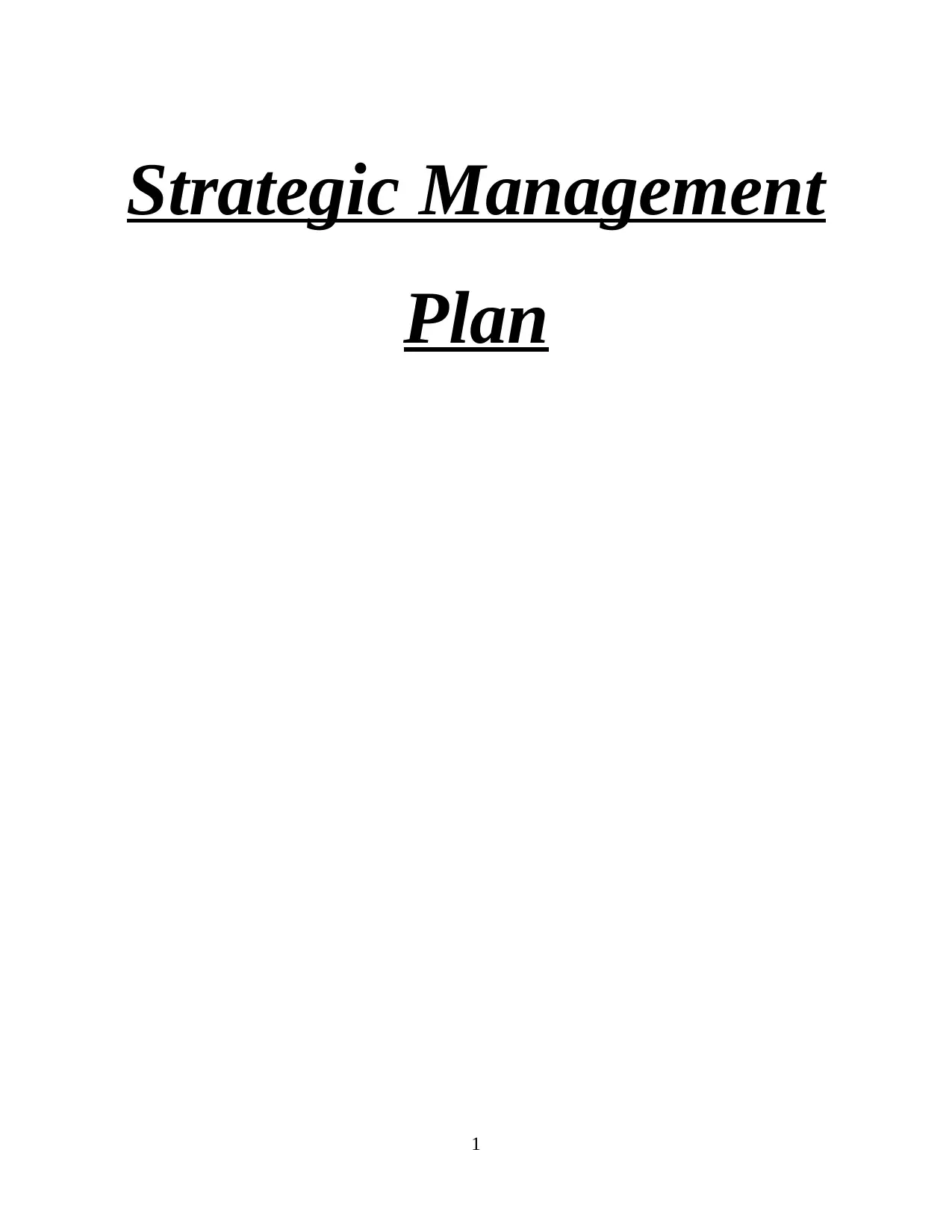
Strategic Management
Plan
1
Plan
1
Secure Best Marks with AI Grader
Need help grading? Try our AI Grader for instant feedback on your assignments.
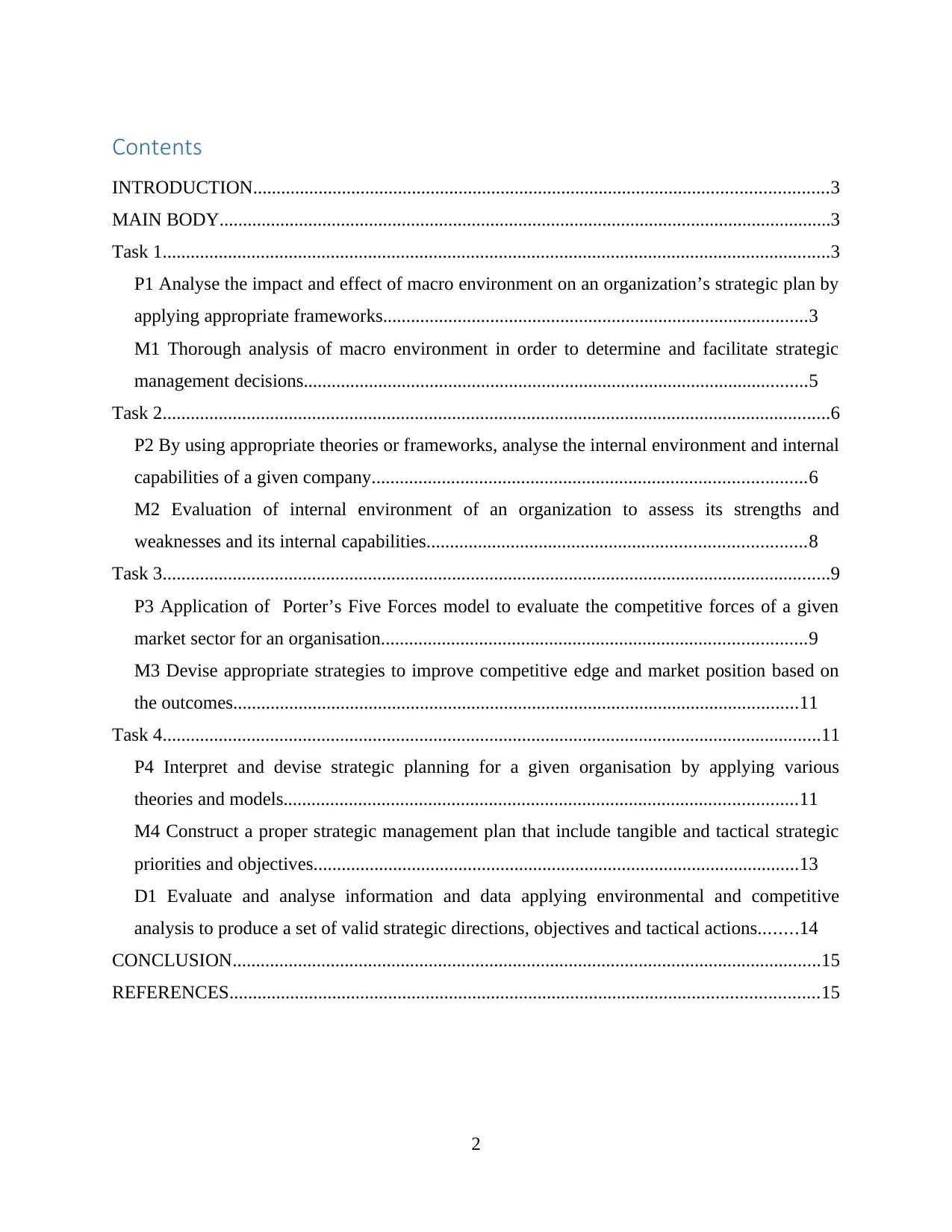
Contents
INTRODUCTION...........................................................................................................................3
MAIN BODY...................................................................................................................................3
Task 1...............................................................................................................................................3
P1 Analyse the impact and effect of macro environment on an organization’s strategic plan by
applying appropriate frameworks...........................................................................................3
M1 Thorough analysis of macro environment in order to determine and facilitate strategic
management decisions............................................................................................................5
Task 2...............................................................................................................................................6
P2 By using appropriate theories or frameworks, analyse the internal environment and internal
capabilities of a given company.............................................................................................6
M2 Evaluation of internal environment of an organization to assess its strengths and
weaknesses and its internal capabilities.................................................................................8
Task 3...............................................................................................................................................9
P3 Application of Porter’s Five Forces model to evaluate the competitive forces of a given
market sector for an organisation...........................................................................................9
M3 Devise appropriate strategies to improve competitive edge and market position based on
the outcomes.........................................................................................................................11
Task 4.............................................................................................................................................11
P4 Interpret and devise strategic planning for a given organisation by applying various
theories and models..............................................................................................................11
M4 Construct a proper strategic management plan that include tangible and tactical strategic
priorities and objectives........................................................................................................13
D1 Evaluate and analyse information and data applying environmental and competitive
analysis to produce a set of valid strategic directions, objectives and tactical actions........14
CONCLUSION..............................................................................................................................15
REFERENCES..............................................................................................................................15
2
INTRODUCTION...........................................................................................................................3
MAIN BODY...................................................................................................................................3
Task 1...............................................................................................................................................3
P1 Analyse the impact and effect of macro environment on an organization’s strategic plan by
applying appropriate frameworks...........................................................................................3
M1 Thorough analysis of macro environment in order to determine and facilitate strategic
management decisions............................................................................................................5
Task 2...............................................................................................................................................6
P2 By using appropriate theories or frameworks, analyse the internal environment and internal
capabilities of a given company.............................................................................................6
M2 Evaluation of internal environment of an organization to assess its strengths and
weaknesses and its internal capabilities.................................................................................8
Task 3...............................................................................................................................................9
P3 Application of Porter’s Five Forces model to evaluate the competitive forces of a given
market sector for an organisation...........................................................................................9
M3 Devise appropriate strategies to improve competitive edge and market position based on
the outcomes.........................................................................................................................11
Task 4.............................................................................................................................................11
P4 Interpret and devise strategic planning for a given organisation by applying various
theories and models..............................................................................................................11
M4 Construct a proper strategic management plan that include tangible and tactical strategic
priorities and objectives........................................................................................................13
D1 Evaluate and analyse information and data applying environmental and competitive
analysis to produce a set of valid strategic directions, objectives and tactical actions........14
CONCLUSION..............................................................................................................................15
REFERENCES..............................................................................................................................15
2
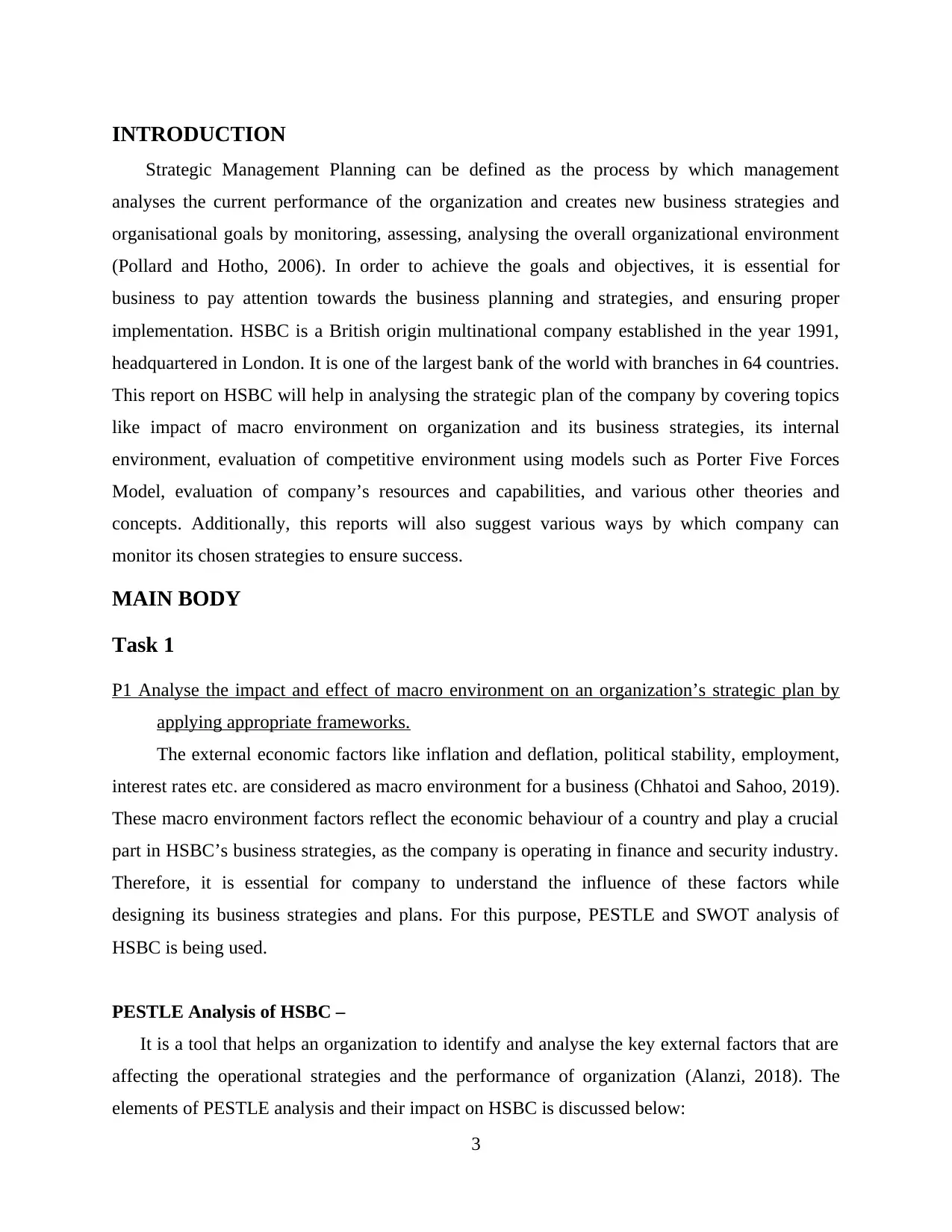
INTRODUCTION
Strategic Management Planning can be defined as the process by which management
analyses the current performance of the organization and creates new business strategies and
organisational goals by monitoring, assessing, analysing the overall organizational environment
(Pollard and Hotho, 2006). In order to achieve the goals and objectives, it is essential for
business to pay attention towards the business planning and strategies, and ensuring proper
implementation. HSBC is a British origin multinational company established in the year 1991,
headquartered in London. It is one of the largest bank of the world with branches in 64 countries.
This report on HSBC will help in analysing the strategic plan of the company by covering topics
like impact of macro environment on organization and its business strategies, its internal
environment, evaluation of competitive environment using models such as Porter Five Forces
Model, evaluation of company’s resources and capabilities, and various other theories and
concepts. Additionally, this reports will also suggest various ways by which company can
monitor its chosen strategies to ensure success.
MAIN BODY
Task 1
P1 Analyse the impact and effect of macro environment on an organization’s strategic plan by
applying appropriate frameworks.
The external economic factors like inflation and deflation, political stability, employment,
interest rates etc. are considered as macro environment for a business (Chhatoi and Sahoo, 2019).
These macro environment factors reflect the economic behaviour of a country and play a crucial
part in HSBC’s business strategies, as the company is operating in finance and security industry.
Therefore, it is essential for company to understand the influence of these factors while
designing its business strategies and plans. For this purpose, PESTLE and SWOT analysis of
HSBC is being used.
PESTLE Analysis of HSBC –
It is a tool that helps an organization to identify and analyse the key external factors that are
affecting the operational strategies and the performance of organization (Alanzi, 2018). The
elements of PESTLE analysis and their impact on HSBC is discussed below:
3
Strategic Management Planning can be defined as the process by which management
analyses the current performance of the organization and creates new business strategies and
organisational goals by monitoring, assessing, analysing the overall organizational environment
(Pollard and Hotho, 2006). In order to achieve the goals and objectives, it is essential for
business to pay attention towards the business planning and strategies, and ensuring proper
implementation. HSBC is a British origin multinational company established in the year 1991,
headquartered in London. It is one of the largest bank of the world with branches in 64 countries.
This report on HSBC will help in analysing the strategic plan of the company by covering topics
like impact of macro environment on organization and its business strategies, its internal
environment, evaluation of competitive environment using models such as Porter Five Forces
Model, evaluation of company’s resources and capabilities, and various other theories and
concepts. Additionally, this reports will also suggest various ways by which company can
monitor its chosen strategies to ensure success.
MAIN BODY
Task 1
P1 Analyse the impact and effect of macro environment on an organization’s strategic plan by
applying appropriate frameworks.
The external economic factors like inflation and deflation, political stability, employment,
interest rates etc. are considered as macro environment for a business (Chhatoi and Sahoo, 2019).
These macro environment factors reflect the economic behaviour of a country and play a crucial
part in HSBC’s business strategies, as the company is operating in finance and security industry.
Therefore, it is essential for company to understand the influence of these factors while
designing its business strategies and plans. For this purpose, PESTLE and SWOT analysis of
HSBC is being used.
PESTLE Analysis of HSBC –
It is a tool that helps an organization to identify and analyse the key external factors that are
affecting the operational strategies and the performance of organization (Alanzi, 2018). The
elements of PESTLE analysis and their impact on HSBC is discussed below:
3
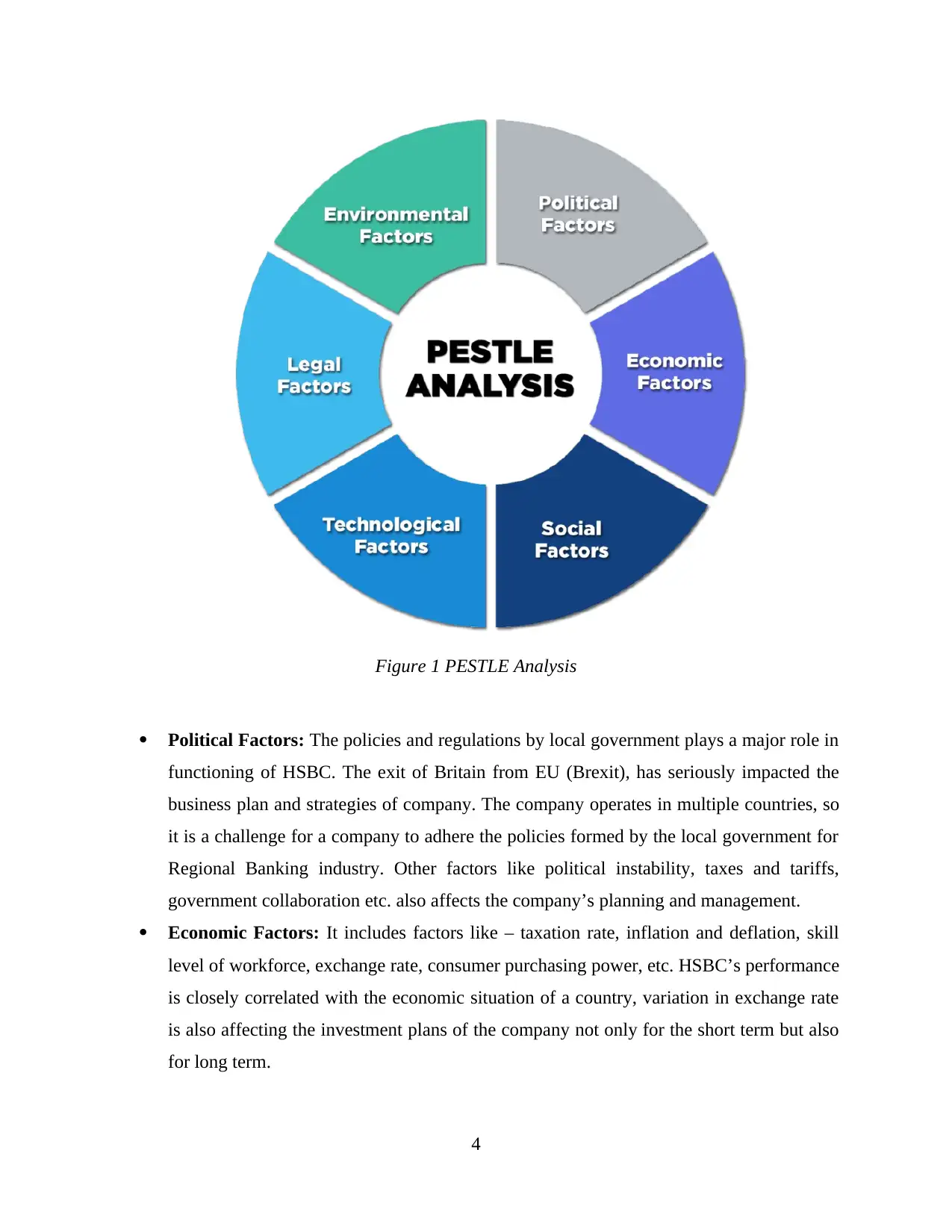
Figure 1 PESTLE Analysis
Political Factors: The policies and regulations by local government plays a major role in
functioning of HSBC. The exit of Britain from EU (Brexit), has seriously impacted the
business plan and strategies of company. The company operates in multiple countries, so
it is a challenge for a company to adhere the policies formed by the local government for
Regional Banking industry. Other factors like political instability, taxes and tariffs,
government collaboration etc. also affects the company’s planning and management.
Economic Factors: It includes factors like – taxation rate, inflation and deflation, skill
level of workforce, exchange rate, consumer purchasing power, etc. HSBC’s performance
is closely correlated with the economic situation of a country, variation in exchange rate
is also affecting the investment plans of the company not only for the short term but also
for long term.
4
Political Factors: The policies and regulations by local government plays a major role in
functioning of HSBC. The exit of Britain from EU (Brexit), has seriously impacted the
business plan and strategies of company. The company operates in multiple countries, so
it is a challenge for a company to adhere the policies formed by the local government for
Regional Banking industry. Other factors like political instability, taxes and tariffs,
government collaboration etc. also affects the company’s planning and management.
Economic Factors: It includes factors like – taxation rate, inflation and deflation, skill
level of workforce, exchange rate, consumer purchasing power, etc. HSBC’s performance
is closely correlated with the economic situation of a country, variation in exchange rate
is also affecting the investment plans of the company not only for the short term but also
for long term.
4
Secure Best Marks with AI Grader
Need help grading? Try our AI Grader for instant feedback on your assignments.
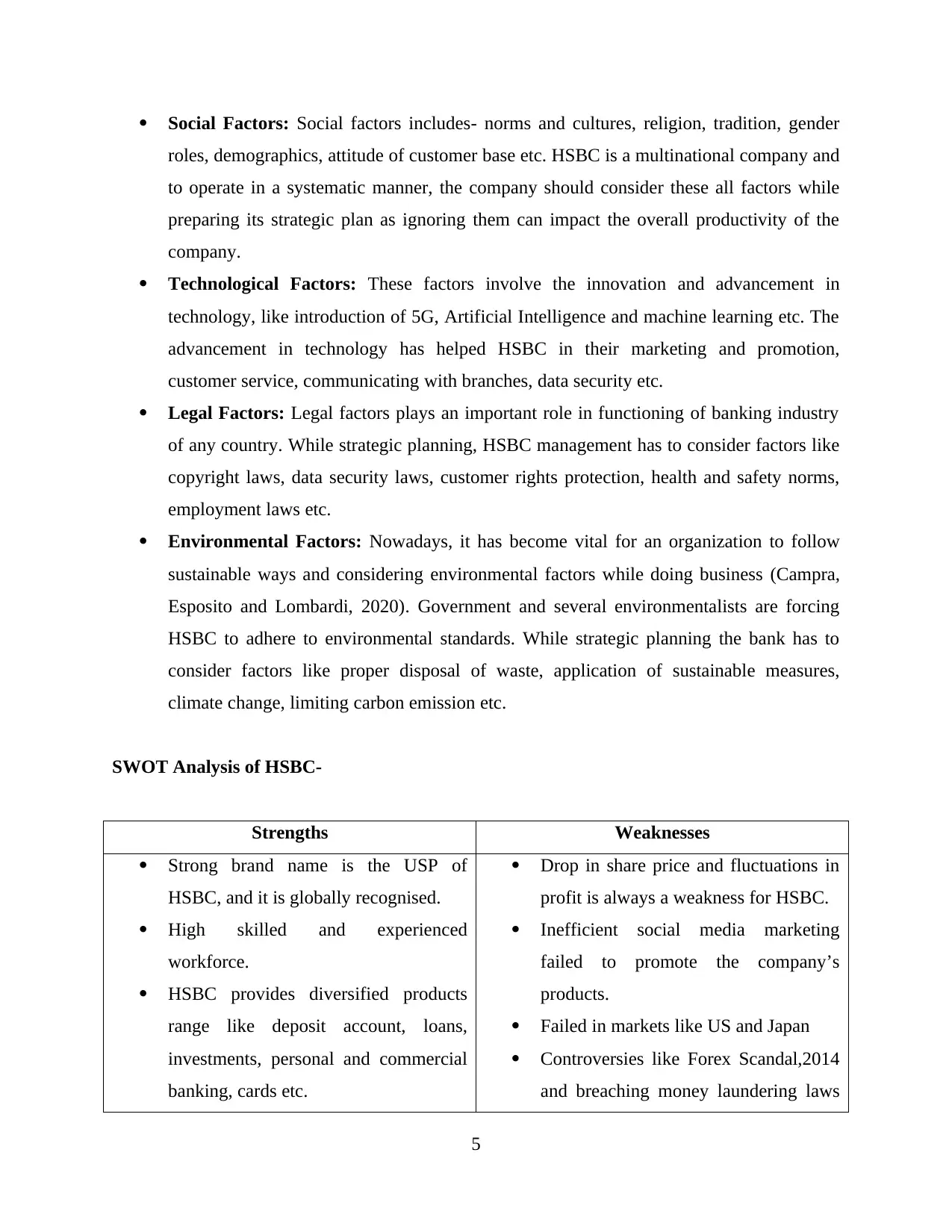
Social Factors: Social factors includes- norms and cultures, religion, tradition, gender
roles, demographics, attitude of customer base etc. HSBC is a multinational company and
to operate in a systematic manner, the company should consider these all factors while
preparing its strategic plan as ignoring them can impact the overall productivity of the
company.
Technological Factors: These factors involve the innovation and advancement in
technology, like introduction of 5G, Artificial Intelligence and machine learning etc. The
advancement in technology has helped HSBC in their marketing and promotion,
customer service, communicating with branches, data security etc.
Legal Factors: Legal factors plays an important role in functioning of banking industry
of any country. While strategic planning, HSBC management has to consider factors like
copyright laws, data security laws, customer rights protection, health and safety norms,
employment laws etc.
Environmental Factors: Nowadays, it has become vital for an organization to follow
sustainable ways and considering environmental factors while doing business (Campra,
Esposito and Lombardi, 2020). Government and several environmentalists are forcing
HSBC to adhere to environmental standards. While strategic planning the bank has to
consider factors like proper disposal of waste, application of sustainable measures,
climate change, limiting carbon emission etc.
SWOT Analysis of HSBC-
Strengths Weaknesses
Strong brand name is the USP of
HSBC, and it is globally recognised.
High skilled and experienced
workforce.
HSBC provides diversified products
range like deposit account, loans,
investments, personal and commercial
banking, cards etc.
Drop in share price and fluctuations in
profit is always a weakness for HSBC.
Inefficient social media marketing
failed to promote the company’s
products.
Failed in markets like US and Japan
Controversies like Forex Scandal,2014
and breaching money laundering laws
5
roles, demographics, attitude of customer base etc. HSBC is a multinational company and
to operate in a systematic manner, the company should consider these all factors while
preparing its strategic plan as ignoring them can impact the overall productivity of the
company.
Technological Factors: These factors involve the innovation and advancement in
technology, like introduction of 5G, Artificial Intelligence and machine learning etc. The
advancement in technology has helped HSBC in their marketing and promotion,
customer service, communicating with branches, data security etc.
Legal Factors: Legal factors plays an important role in functioning of banking industry
of any country. While strategic planning, HSBC management has to consider factors like
copyright laws, data security laws, customer rights protection, health and safety norms,
employment laws etc.
Environmental Factors: Nowadays, it has become vital for an organization to follow
sustainable ways and considering environmental factors while doing business (Campra,
Esposito and Lombardi, 2020). Government and several environmentalists are forcing
HSBC to adhere to environmental standards. While strategic planning the bank has to
consider factors like proper disposal of waste, application of sustainable measures,
climate change, limiting carbon emission etc.
SWOT Analysis of HSBC-
Strengths Weaknesses
Strong brand name is the USP of
HSBC, and it is globally recognised.
High skilled and experienced
workforce.
HSBC provides diversified products
range like deposit account, loans,
investments, personal and commercial
banking, cards etc.
Drop in share price and fluctuations in
profit is always a weakness for HSBC.
Inefficient social media marketing
failed to promote the company’s
products.
Failed in markets like US and Japan
Controversies like Forex Scandal,2014
and breaching money laundering laws
5
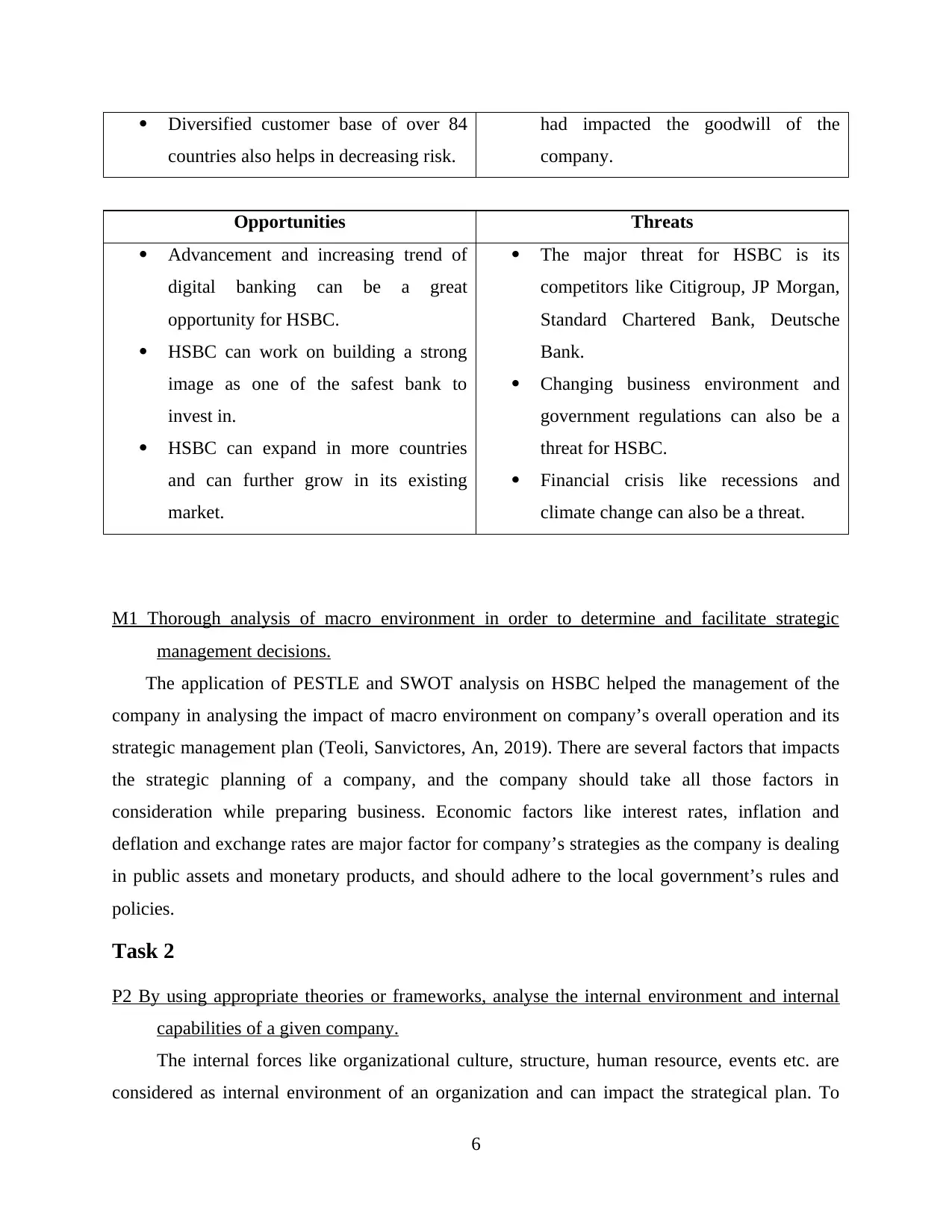
Diversified customer base of over 84
countries also helps in decreasing risk.
had impacted the goodwill of the
company.
Opportunities Threats
Advancement and increasing trend of
digital banking can be a great
opportunity for HSBC.
HSBC can work on building a strong
image as one of the safest bank to
invest in.
HSBC can expand in more countries
and can further grow in its existing
market.
The major threat for HSBC is its
competitors like Citigroup, JP Morgan,
Standard Chartered Bank, Deutsche
Bank.
Changing business environment and
government regulations can also be a
threat for HSBC.
Financial crisis like recessions and
climate change can also be a threat.
M1 Thorough analysis of macro environment in order to determine and facilitate strategic
management decisions.
The application of PESTLE and SWOT analysis on HSBC helped the management of the
company in analysing the impact of macro environment on company’s overall operation and its
strategic management plan (Teoli, Sanvictores, An, 2019). There are several factors that impacts
the strategic planning of a company, and the company should take all those factors in
consideration while preparing business. Economic factors like interest rates, inflation and
deflation and exchange rates are major factor for company’s strategies as the company is dealing
in public assets and monetary products, and should adhere to the local government’s rules and
policies.
Task 2
P2 By using appropriate theories or frameworks, analyse the internal environment and internal
capabilities of a given company.
The internal forces like organizational culture, structure, human resource, events etc. are
considered as internal environment of an organization and can impact the strategical plan. To
6
countries also helps in decreasing risk.
had impacted the goodwill of the
company.
Opportunities Threats
Advancement and increasing trend of
digital banking can be a great
opportunity for HSBC.
HSBC can work on building a strong
image as one of the safest bank to
invest in.
HSBC can expand in more countries
and can further grow in its existing
market.
The major threat for HSBC is its
competitors like Citigroup, JP Morgan,
Standard Chartered Bank, Deutsche
Bank.
Changing business environment and
government regulations can also be a
threat for HSBC.
Financial crisis like recessions and
climate change can also be a threat.
M1 Thorough analysis of macro environment in order to determine and facilitate strategic
management decisions.
The application of PESTLE and SWOT analysis on HSBC helped the management of the
company in analysing the impact of macro environment on company’s overall operation and its
strategic management plan (Teoli, Sanvictores, An, 2019). There are several factors that impacts
the strategic planning of a company, and the company should take all those factors in
consideration while preparing business. Economic factors like interest rates, inflation and
deflation and exchange rates are major factor for company’s strategies as the company is dealing
in public assets and monetary products, and should adhere to the local government’s rules and
policies.
Task 2
P2 By using appropriate theories or frameworks, analyse the internal environment and internal
capabilities of a given company.
The internal forces like organizational culture, structure, human resource, events etc. are
considered as internal environment of an organization and can impact the strategical plan. To
6
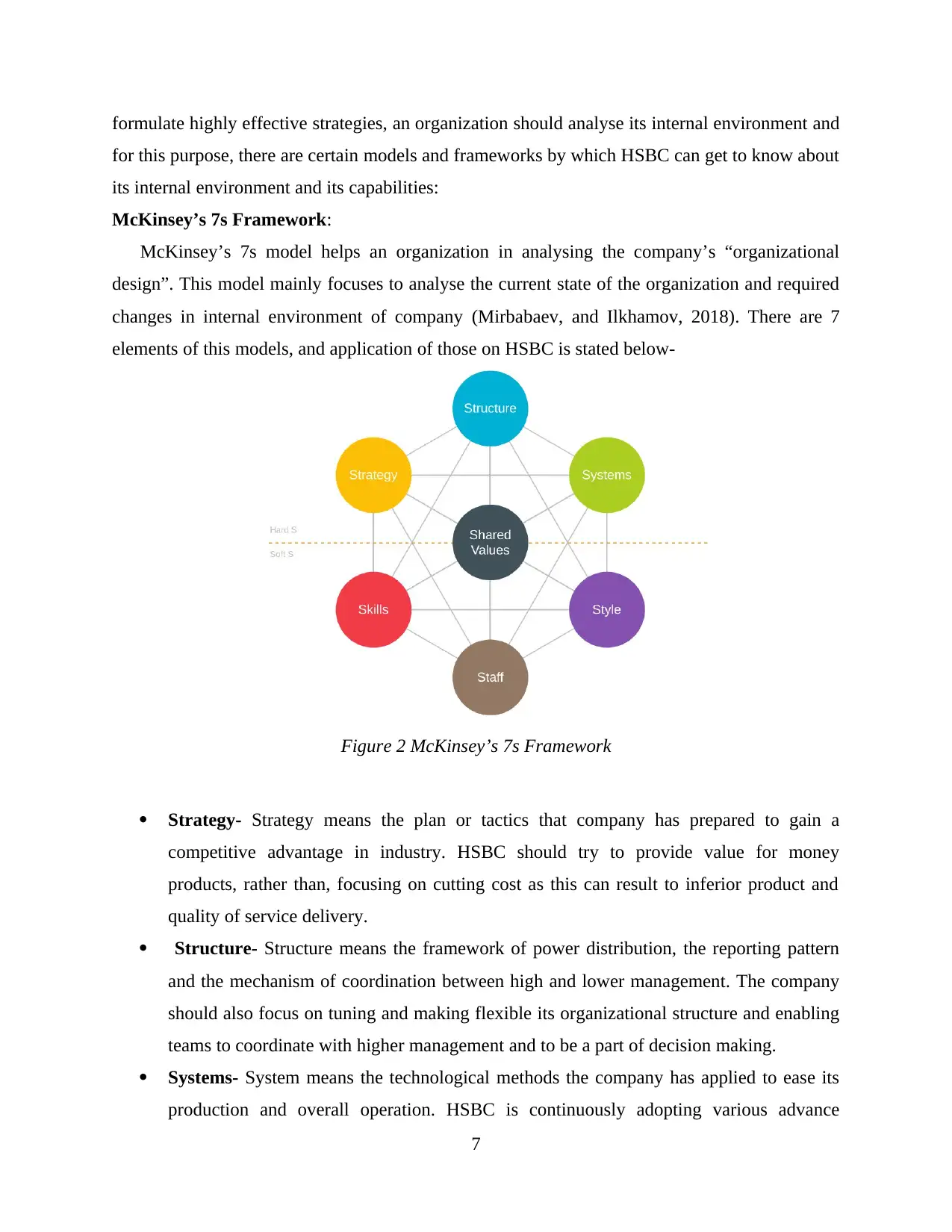
formulate highly effective strategies, an organization should analyse its internal environment and
for this purpose, there are certain models and frameworks by which HSBC can get to know about
its internal environment and its capabilities:
McKinsey’s 7s Framework:
McKinsey’s 7s model helps an organization in analysing the company’s “organizational
design”. This model mainly focuses to analyse the current state of the organization and required
changes in internal environment of company (Mirbabaev, and Ilkhamov, 2018). There are 7
elements of this models, and application of those on HSBC is stated below-
Figure 2 McKinsey’s 7s Framework
Strategy- Strategy means the plan or tactics that company has prepared to gain a
competitive advantage in industry. HSBC should try to provide value for money
products, rather than, focusing on cutting cost as this can result to inferior product and
quality of service delivery.
Structure- Structure means the framework of power distribution, the reporting pattern
and the mechanism of coordination between high and lower management. The company
should also focus on tuning and making flexible its organizational structure and enabling
teams to coordinate with higher management and to be a part of decision making.
Systems- System means the technological methods the company has applied to ease its
production and overall operation. HSBC is continuously adopting various advance
7
for this purpose, there are certain models and frameworks by which HSBC can get to know about
its internal environment and its capabilities:
McKinsey’s 7s Framework:
McKinsey’s 7s model helps an organization in analysing the company’s “organizational
design”. This model mainly focuses to analyse the current state of the organization and required
changes in internal environment of company (Mirbabaev, and Ilkhamov, 2018). There are 7
elements of this models, and application of those on HSBC is stated below-
Figure 2 McKinsey’s 7s Framework
Strategy- Strategy means the plan or tactics that company has prepared to gain a
competitive advantage in industry. HSBC should try to provide value for money
products, rather than, focusing on cutting cost as this can result to inferior product and
quality of service delivery.
Structure- Structure means the framework of power distribution, the reporting pattern
and the mechanism of coordination between high and lower management. The company
should also focus on tuning and making flexible its organizational structure and enabling
teams to coordinate with higher management and to be a part of decision making.
Systems- System means the technological methods the company has applied to ease its
production and overall operation. HSBC is continuously adopting various advance
7
Paraphrase This Document
Need a fresh take? Get an instant paraphrase of this document with our AI Paraphraser
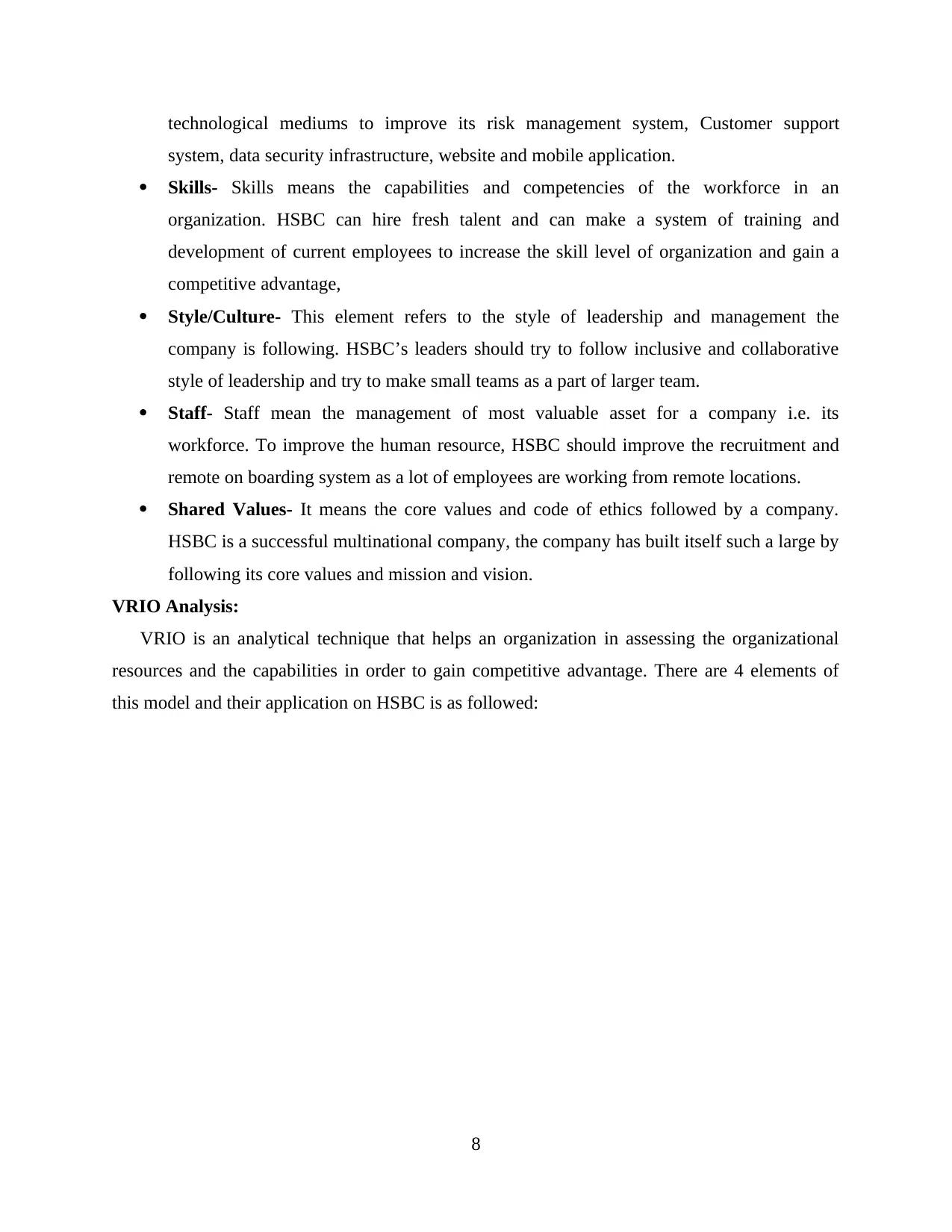
technological mediums to improve its risk management system, Customer support
system, data security infrastructure, website and mobile application.
Skills- Skills means the capabilities and competencies of the workforce in an
organization. HSBC can hire fresh talent and can make a system of training and
development of current employees to increase the skill level of organization and gain a
competitive advantage,
Style/Culture- This element refers to the style of leadership and management the
company is following. HSBC’s leaders should try to follow inclusive and collaborative
style of leadership and try to make small teams as a part of larger team.
Staff- Staff mean the management of most valuable asset for a company i.e. its
workforce. To improve the human resource, HSBC should improve the recruitment and
remote on boarding system as a lot of employees are working from remote locations.
Shared Values- It means the core values and code of ethics followed by a company.
HSBC is a successful multinational company, the company has built itself such a large by
following its core values and mission and vision.
VRIO Analysis:
VRIO is an analytical technique that helps an organization in assessing the organizational
resources and the capabilities in order to gain competitive advantage. There are 4 elements of
this model and their application on HSBC is as followed:
8
system, data security infrastructure, website and mobile application.
Skills- Skills means the capabilities and competencies of the workforce in an
organization. HSBC can hire fresh talent and can make a system of training and
development of current employees to increase the skill level of organization and gain a
competitive advantage,
Style/Culture- This element refers to the style of leadership and management the
company is following. HSBC’s leaders should try to follow inclusive and collaborative
style of leadership and try to make small teams as a part of larger team.
Staff- Staff mean the management of most valuable asset for a company i.e. its
workforce. To improve the human resource, HSBC should improve the recruitment and
remote on boarding system as a lot of employees are working from remote locations.
Shared Values- It means the core values and code of ethics followed by a company.
HSBC is a successful multinational company, the company has built itself such a large by
following its core values and mission and vision.
VRIO Analysis:
VRIO is an analytical technique that helps an organization in assessing the organizational
resources and the capabilities in order to gain competitive advantage. There are 4 elements of
this model and their application on HSBC is as followed:
8
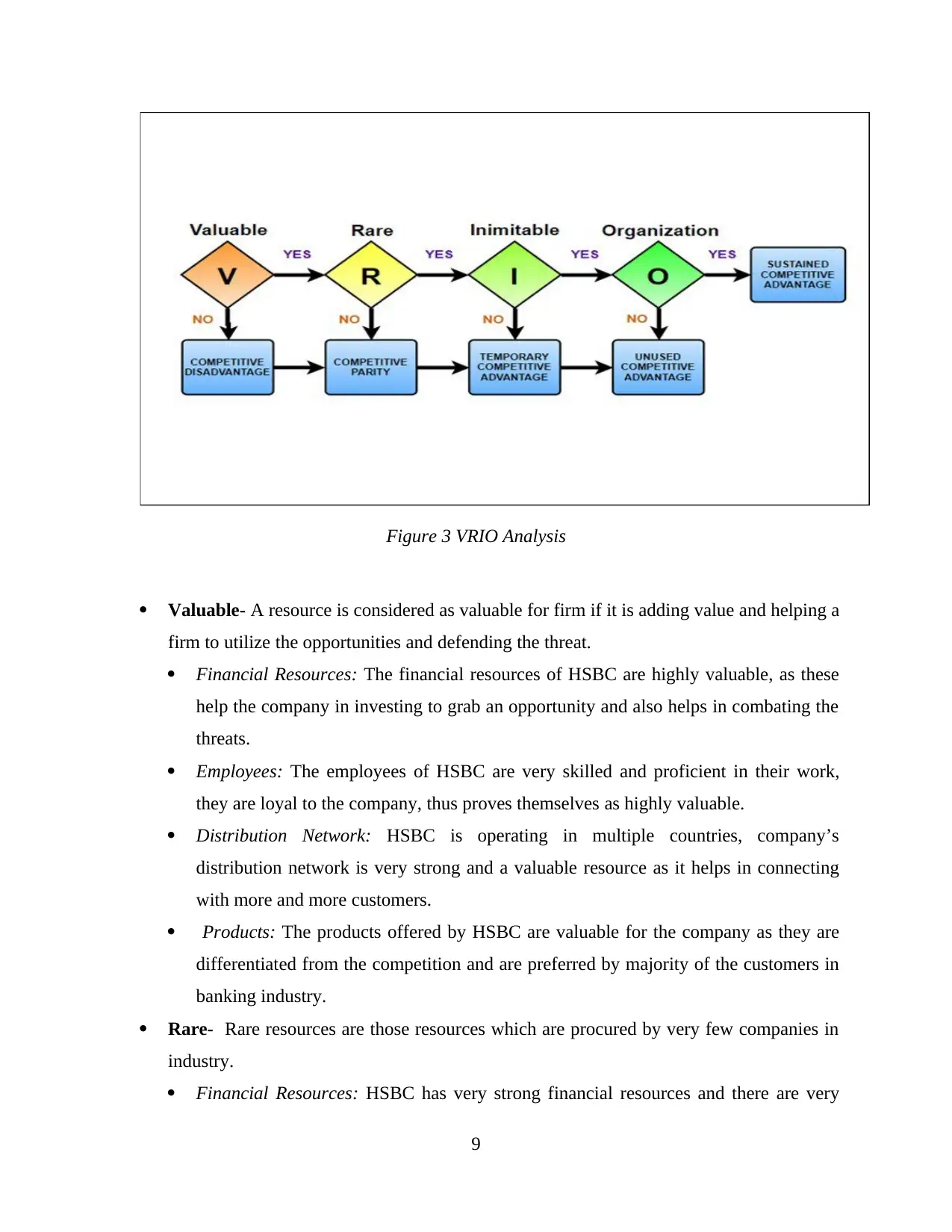
Figure 3 VRIO Analysis
Valuable- A resource is considered as valuable for firm if it is adding value and helping a
firm to utilize the opportunities and defending the threat.
Financial Resources: The financial resources of HSBC are highly valuable, as these
help the company in investing to grab an opportunity and also helps in combating the
threats.
Employees: The employees of HSBC are very skilled and proficient in their work,
they are loyal to the company, thus proves themselves as highly valuable.
Distribution Network: HSBC is operating in multiple countries, company’s
distribution network is very strong and a valuable resource as it helps in connecting
with more and more customers.
Products: The products offered by HSBC are valuable for the company as they are
differentiated from the competition and are preferred by majority of the customers in
banking industry.
Rare- Rare resources are those resources which are procured by very few companies in
industry.
Financial Resources: HSBC has very strong financial resources and there are very
9
Valuable- A resource is considered as valuable for firm if it is adding value and helping a
firm to utilize the opportunities and defending the threat.
Financial Resources: The financial resources of HSBC are highly valuable, as these
help the company in investing to grab an opportunity and also helps in combating the
threats.
Employees: The employees of HSBC are very skilled and proficient in their work,
they are loyal to the company, thus proves themselves as highly valuable.
Distribution Network: HSBC is operating in multiple countries, company’s
distribution network is very strong and a valuable resource as it helps in connecting
with more and more customers.
Products: The products offered by HSBC are valuable for the company as they are
differentiated from the competition and are preferred by majority of the customers in
banking industry.
Rare- Rare resources are those resources which are procured by very few companies in
industry.
Financial Resources: HSBC has very strong financial resources and there are very
9
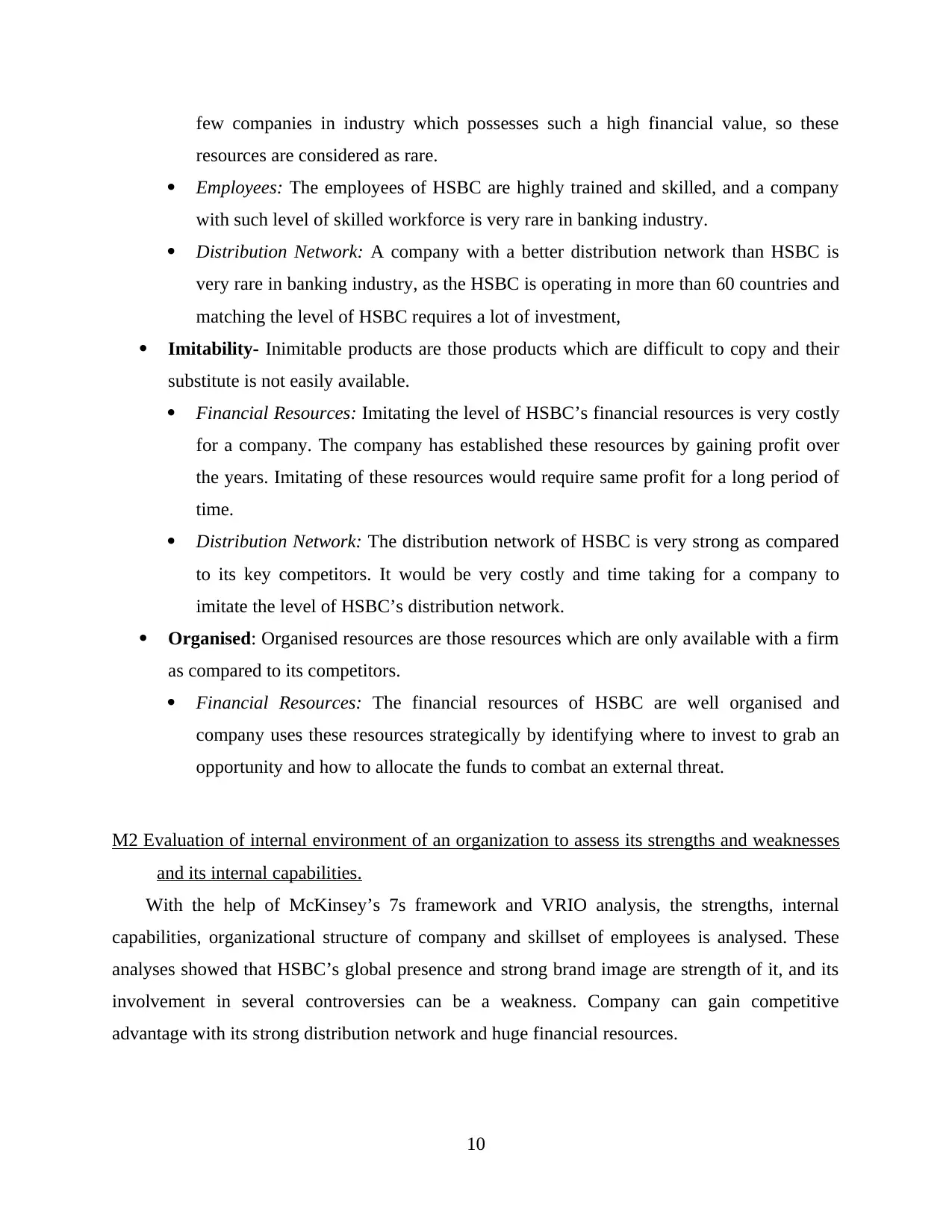
few companies in industry which possesses such a high financial value, so these
resources are considered as rare.
Employees: The employees of HSBC are highly trained and skilled, and a company
with such level of skilled workforce is very rare in banking industry.
Distribution Network: A company with a better distribution network than HSBC is
very rare in banking industry, as the HSBC is operating in more than 60 countries and
matching the level of HSBC requires a lot of investment,
Imitability- Inimitable products are those products which are difficult to copy and their
substitute is not easily available.
Financial Resources: Imitating the level of HSBC’s financial resources is very costly
for a company. The company has established these resources by gaining profit over
the years. Imitating of these resources would require same profit for a long period of
time.
Distribution Network: The distribution network of HSBC is very strong as compared
to its key competitors. It would be very costly and time taking for a company to
imitate the level of HSBC’s distribution network.
Organised: Organised resources are those resources which are only available with a firm
as compared to its competitors.
Financial Resources: The financial resources of HSBC are well organised and
company uses these resources strategically by identifying where to invest to grab an
opportunity and how to allocate the funds to combat an external threat.
M2 Evaluation of internal environment of an organization to assess its strengths and weaknesses
and its internal capabilities.
With the help of McKinsey’s 7s framework and VRIO analysis, the strengths, internal
capabilities, organizational structure of company and skillset of employees is analysed. These
analyses showed that HSBC’s global presence and strong brand image are strength of it, and its
involvement in several controversies can be a weakness. Company can gain competitive
advantage with its strong distribution network and huge financial resources.
10
resources are considered as rare.
Employees: The employees of HSBC are highly trained and skilled, and a company
with such level of skilled workforce is very rare in banking industry.
Distribution Network: A company with a better distribution network than HSBC is
very rare in banking industry, as the HSBC is operating in more than 60 countries and
matching the level of HSBC requires a lot of investment,
Imitability- Inimitable products are those products which are difficult to copy and their
substitute is not easily available.
Financial Resources: Imitating the level of HSBC’s financial resources is very costly
for a company. The company has established these resources by gaining profit over
the years. Imitating of these resources would require same profit for a long period of
time.
Distribution Network: The distribution network of HSBC is very strong as compared
to its key competitors. It would be very costly and time taking for a company to
imitate the level of HSBC’s distribution network.
Organised: Organised resources are those resources which are only available with a firm
as compared to its competitors.
Financial Resources: The financial resources of HSBC are well organised and
company uses these resources strategically by identifying where to invest to grab an
opportunity and how to allocate the funds to combat an external threat.
M2 Evaluation of internal environment of an organization to assess its strengths and weaknesses
and its internal capabilities.
With the help of McKinsey’s 7s framework and VRIO analysis, the strengths, internal
capabilities, organizational structure of company and skillset of employees is analysed. These
analyses showed that HSBC’s global presence and strong brand image are strength of it, and its
involvement in several controversies can be a weakness. Company can gain competitive
advantage with its strong distribution network and huge financial resources.
10
Secure Best Marks with AI Grader
Need help grading? Try our AI Grader for instant feedback on your assignments.
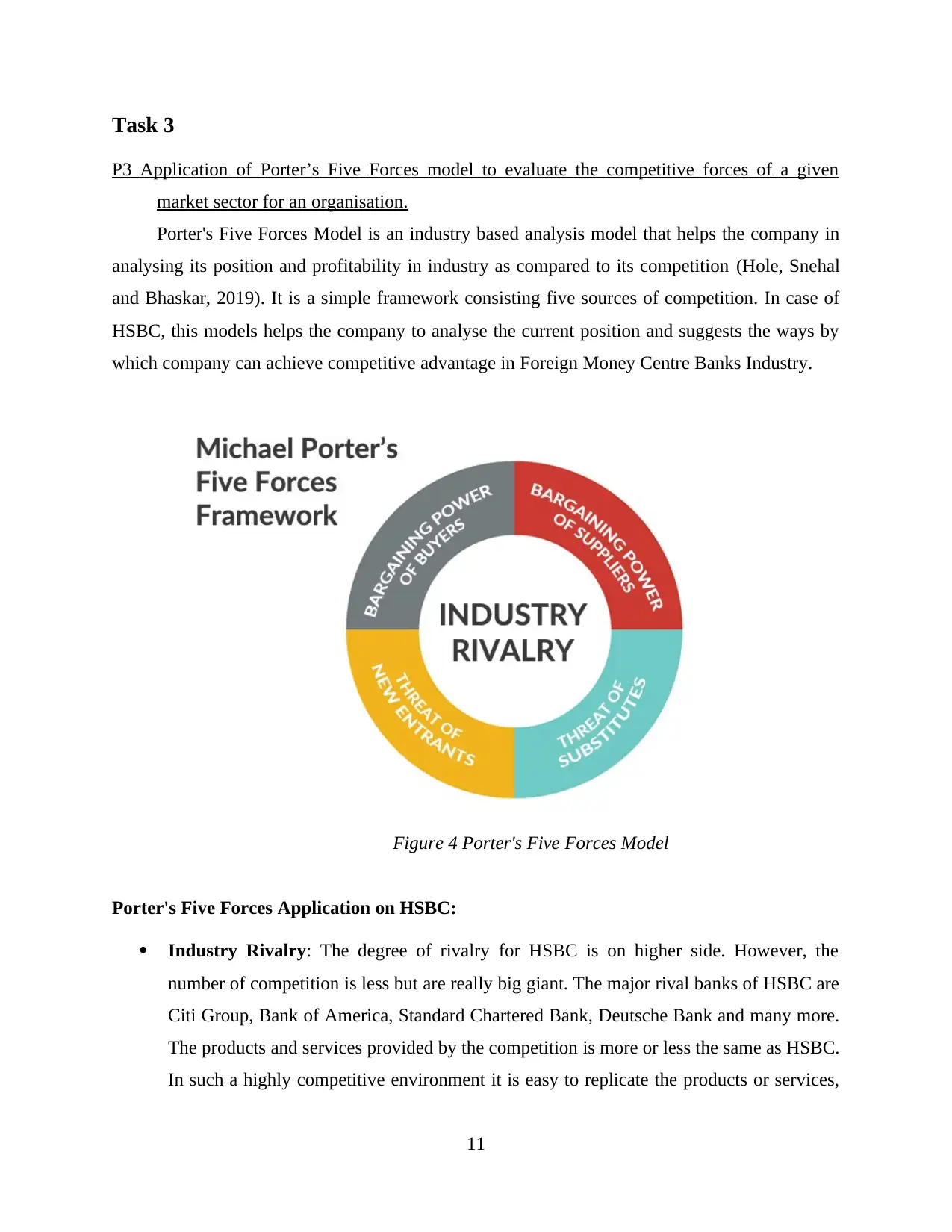
Task 3
P3 Application of Porter’s Five Forces model to evaluate the competitive forces of a given
market sector for an organisation.
Porter's Five Forces Model is an industry based analysis model that helps the company in
analysing its position and profitability in industry as compared to its competition (Hole, Snehal
and Bhaskar, 2019). It is a simple framework consisting five sources of competition. In case of
HSBC, this models helps the company to analyse the current position and suggests the ways by
which company can achieve competitive advantage in Foreign Money Centre Banks Industry.
Porter's Five Forces Application on HSBC:
Industry Rivalry: The degree of rivalry for HSBC is on higher side. However, the
number of competition is less but are really big giant. The major rival banks of HSBC are
Citi Group, Bank of America, Standard Chartered Bank, Deutsche Bank and many more.
The products and services provided by the competition is more or less the same as HSBC.
In such a highly competitive environment it is easy to replicate the products or services,
11
Figure 4 Porter's Five Forces Model
P3 Application of Porter’s Five Forces model to evaluate the competitive forces of a given
market sector for an organisation.
Porter's Five Forces Model is an industry based analysis model that helps the company in
analysing its position and profitability in industry as compared to its competition (Hole, Snehal
and Bhaskar, 2019). It is a simple framework consisting five sources of competition. In case of
HSBC, this models helps the company to analyse the current position and suggests the ways by
which company can achieve competitive advantage in Foreign Money Centre Banks Industry.
Porter's Five Forces Application on HSBC:
Industry Rivalry: The degree of rivalry for HSBC is on higher side. However, the
number of competition is less but are really big giant. The major rival banks of HSBC are
Citi Group, Bank of America, Standard Chartered Bank, Deutsche Bank and many more.
The products and services provided by the competition is more or less the same as HSBC.
In such a highly competitive environment it is easy to replicate the products or services,
11
Figure 4 Porter's Five Forces Model
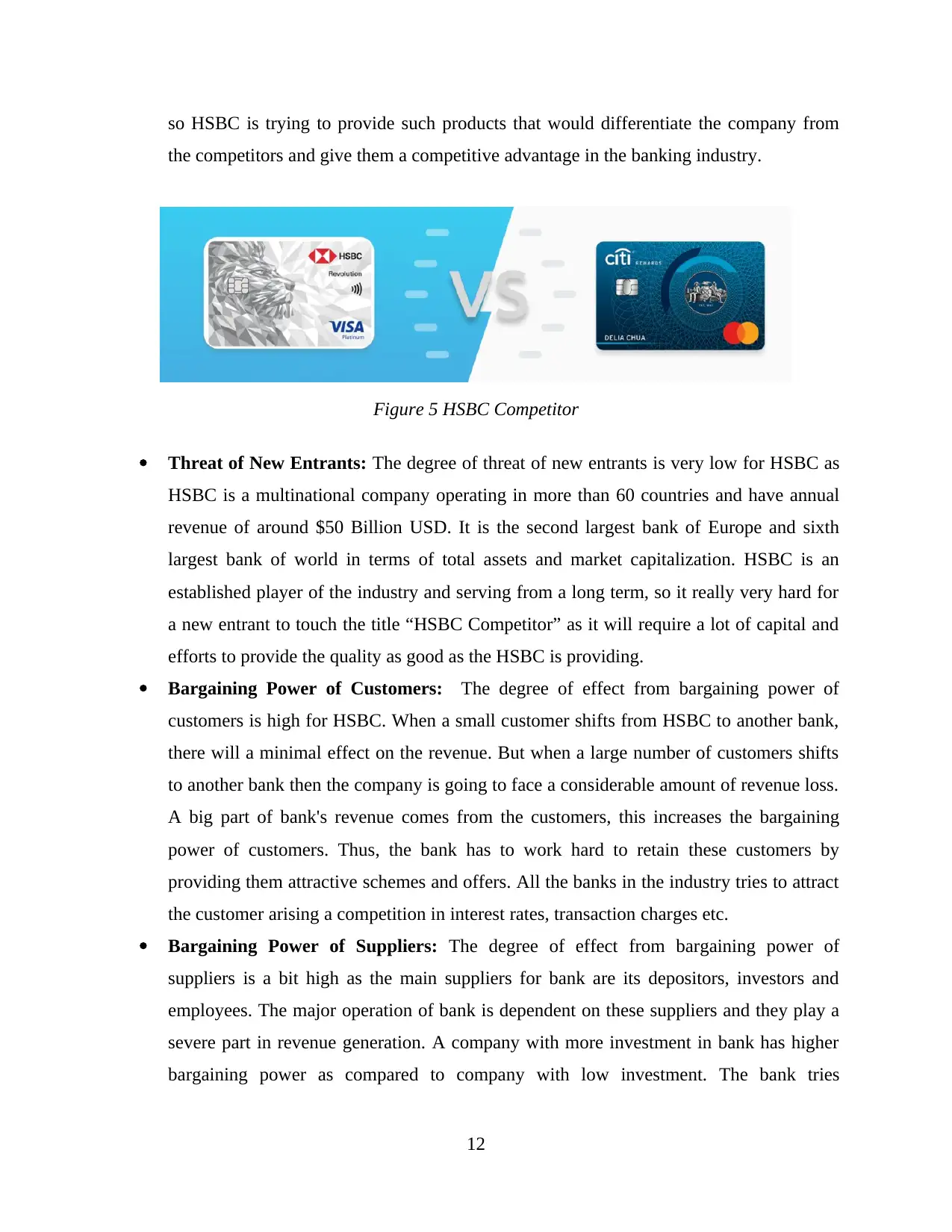
so HSBC is trying to provide such products that would differentiate the company from
the competitors and give them a competitive advantage in the banking industry.
Threat of New Entrants: The degree of threat of new entrants is very low for HSBC as
HSBC is a multinational company operating in more than 60 countries and have annual
revenue of around $50 Billion USD. It is the second largest bank of Europe and sixth
largest bank of world in terms of total assets and market capitalization. HSBC is an
established player of the industry and serving from a long term, so it really very hard for
a new entrant to touch the title “HSBC Competitor” as it will require a lot of capital and
efforts to provide the quality as good as the HSBC is providing.
Bargaining Power of Customers: The degree of effect from bargaining power of
customers is high for HSBC. When a small customer shifts from HSBC to another bank,
there will a minimal effect on the revenue. But when a large number of customers shifts
to another bank then the company is going to face a considerable amount of revenue loss.
A big part of bank's revenue comes from the customers, this increases the bargaining
power of customers. Thus, the bank has to work hard to retain these customers by
providing them attractive schemes and offers. All the banks in the industry tries to attract
the customer arising a competition in interest rates, transaction charges etc.
Bargaining Power of Suppliers: The degree of effect from bargaining power of
suppliers is a bit high as the main suppliers for bank are its depositors, investors and
employees. The major operation of bank is dependent on these suppliers and they play a
severe part in revenue generation. A company with more investment in bank has higher
bargaining power as compared to company with low investment. The bank tries
12
Figure 5 HSBC Competitor
the competitors and give them a competitive advantage in the banking industry.
Threat of New Entrants: The degree of threat of new entrants is very low for HSBC as
HSBC is a multinational company operating in more than 60 countries and have annual
revenue of around $50 Billion USD. It is the second largest bank of Europe and sixth
largest bank of world in terms of total assets and market capitalization. HSBC is an
established player of the industry and serving from a long term, so it really very hard for
a new entrant to touch the title “HSBC Competitor” as it will require a lot of capital and
efforts to provide the quality as good as the HSBC is providing.
Bargaining Power of Customers: The degree of effect from bargaining power of
customers is high for HSBC. When a small customer shifts from HSBC to another bank,
there will a minimal effect on the revenue. But when a large number of customers shifts
to another bank then the company is going to face a considerable amount of revenue loss.
A big part of bank's revenue comes from the customers, this increases the bargaining
power of customers. Thus, the bank has to work hard to retain these customers by
providing them attractive schemes and offers. All the banks in the industry tries to attract
the customer arising a competition in interest rates, transaction charges etc.
Bargaining Power of Suppliers: The degree of effect from bargaining power of
suppliers is a bit high as the main suppliers for bank are its depositors, investors and
employees. The major operation of bank is dependent on these suppliers and they play a
severe part in revenue generation. A company with more investment in bank has higher
bargaining power as compared to company with low investment. The bank tries
12
Figure 5 HSBC Competitor
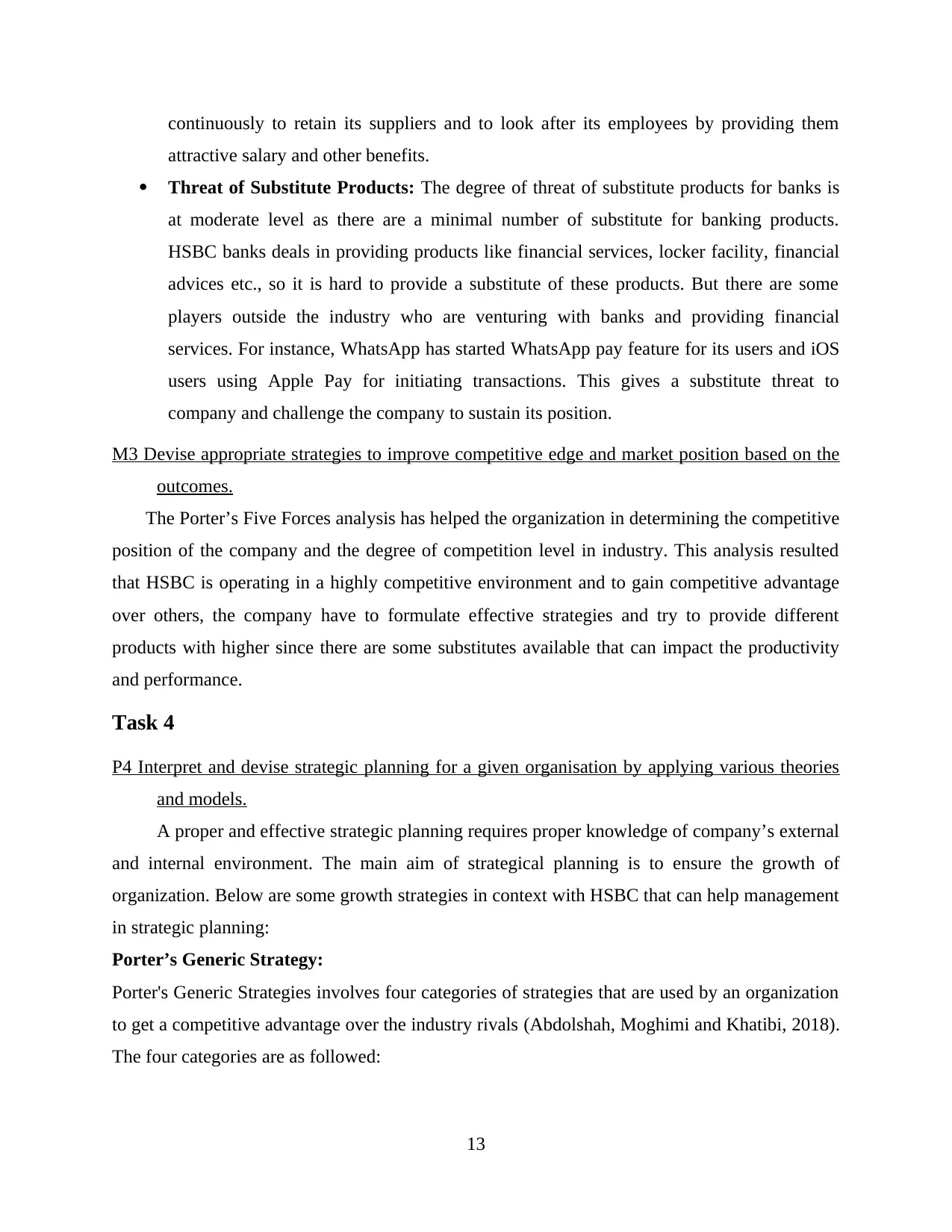
continuously to retain its suppliers and to look after its employees by providing them
attractive salary and other benefits.
Threat of Substitute Products: The degree of threat of substitute products for banks is
at moderate level as there are a minimal number of substitute for banking products.
HSBC banks deals in providing products like financial services, locker facility, financial
advices etc., so it is hard to provide a substitute of these products. But there are some
players outside the industry who are venturing with banks and providing financial
services. For instance, WhatsApp has started WhatsApp pay feature for its users and iOS
users using Apple Pay for initiating transactions. This gives a substitute threat to
company and challenge the company to sustain its position.
M3 Devise appropriate strategies to improve competitive edge and market position based on the
outcomes.
The Porter’s Five Forces analysis has helped the organization in determining the competitive
position of the company and the degree of competition level in industry. This analysis resulted
that HSBC is operating in a highly competitive environment and to gain competitive advantage
over others, the company have to formulate effective strategies and try to provide different
products with higher since there are some substitutes available that can impact the productivity
and performance.
Task 4
P4 Interpret and devise strategic planning for a given organisation by applying various theories
and models.
A proper and effective strategic planning requires proper knowledge of company’s external
and internal environment. The main aim of strategical planning is to ensure the growth of
organization. Below are some growth strategies in context with HSBC that can help management
in strategic planning:
Porter’s Generic Strategy:
Porter's Generic Strategies involves four categories of strategies that are used by an organization
to get a competitive advantage over the industry rivals (Abdolshah, Moghimi and Khatibi, 2018).
The four categories are as followed:
13
attractive salary and other benefits.
Threat of Substitute Products: The degree of threat of substitute products for banks is
at moderate level as there are a minimal number of substitute for banking products.
HSBC banks deals in providing products like financial services, locker facility, financial
advices etc., so it is hard to provide a substitute of these products. But there are some
players outside the industry who are venturing with banks and providing financial
services. For instance, WhatsApp has started WhatsApp pay feature for its users and iOS
users using Apple Pay for initiating transactions. This gives a substitute threat to
company and challenge the company to sustain its position.
M3 Devise appropriate strategies to improve competitive edge and market position based on the
outcomes.
The Porter’s Five Forces analysis has helped the organization in determining the competitive
position of the company and the degree of competition level in industry. This analysis resulted
that HSBC is operating in a highly competitive environment and to gain competitive advantage
over others, the company have to formulate effective strategies and try to provide different
products with higher since there are some substitutes available that can impact the productivity
and performance.
Task 4
P4 Interpret and devise strategic planning for a given organisation by applying various theories
and models.
A proper and effective strategic planning requires proper knowledge of company’s external
and internal environment. The main aim of strategical planning is to ensure the growth of
organization. Below are some growth strategies in context with HSBC that can help management
in strategic planning:
Porter’s Generic Strategy:
Porter's Generic Strategies involves four categories of strategies that are used by an organization
to get a competitive advantage over the industry rivals (Abdolshah, Moghimi and Khatibi, 2018).
The four categories are as followed:
13
Paraphrase This Document
Need a fresh take? Get an instant paraphrase of this document with our AI Paraphraser
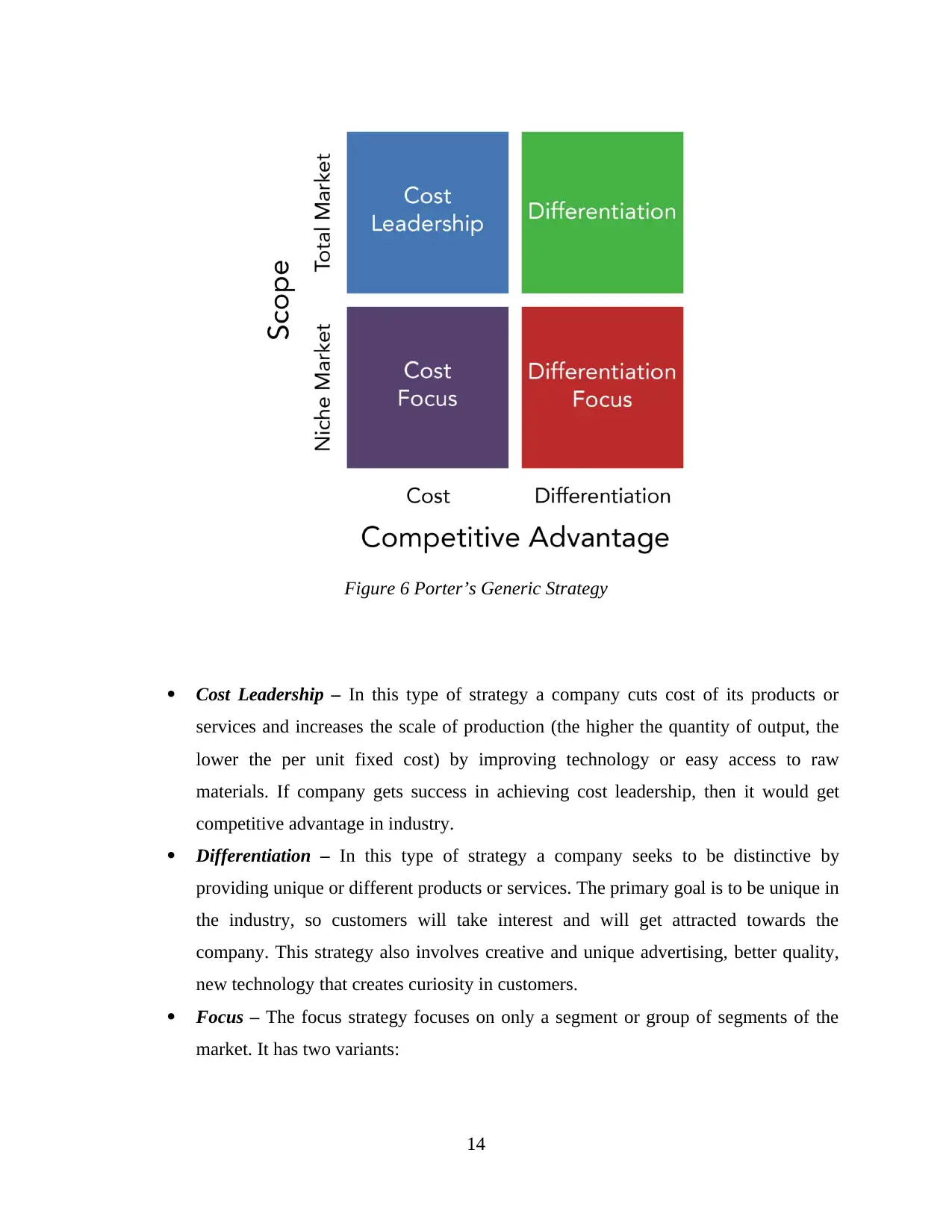
Figure 6 Porter’s Generic Strategy
Cost Leadership – In this type of strategy a company cuts cost of its products or
services and increases the scale of production (the higher the quantity of output, the
lower the per unit fixed cost) by improving technology or easy access to raw
materials. If company gets success in achieving cost leadership, then it would get
competitive advantage in industry.
Differentiation – In this type of strategy a company seeks to be distinctive by
providing unique or different products or services. The primary goal is to be unique in
the industry, so customers will take interest and will get attracted towards the
company. This strategy also involves creative and unique advertising, better quality,
new technology that creates curiosity in customers.
Focus – The focus strategy focuses on only a segment or group of segments of the
market. It has two variants:
14
Cost Leadership – In this type of strategy a company cuts cost of its products or
services and increases the scale of production (the higher the quantity of output, the
lower the per unit fixed cost) by improving technology or easy access to raw
materials. If company gets success in achieving cost leadership, then it would get
competitive advantage in industry.
Differentiation – In this type of strategy a company seeks to be distinctive by
providing unique or different products or services. The primary goal is to be unique in
the industry, so customers will take interest and will get attracted towards the
company. This strategy also involves creative and unique advertising, better quality,
new technology that creates curiosity in customers.
Focus – The focus strategy focuses on only a segment or group of segments of the
market. It has two variants:
14
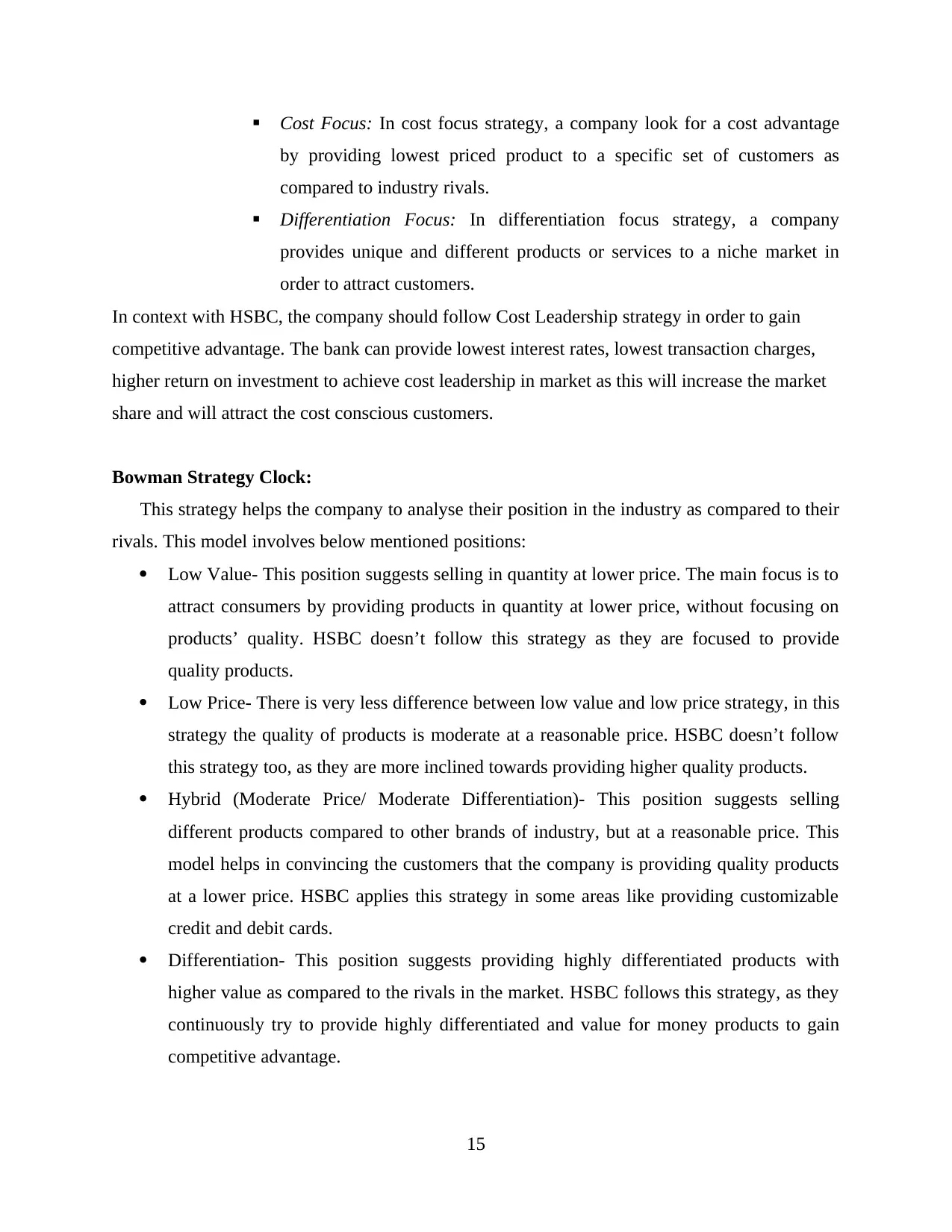
Cost Focus: In cost focus strategy, a company look for a cost advantage
by providing lowest priced product to a specific set of customers as
compared to industry rivals.
Differentiation Focus: In differentiation focus strategy, a company
provides unique and different products or services to a niche market in
order to attract customers.
In context with HSBC, the company should follow Cost Leadership strategy in order to gain
competitive advantage. The bank can provide lowest interest rates, lowest transaction charges,
higher return on investment to achieve cost leadership in market as this will increase the market
share and will attract the cost conscious customers.
Bowman Strategy Clock:
This strategy helps the company to analyse their position in the industry as compared to their
rivals. This model involves below mentioned positions:
Low Value- This position suggests selling in quantity at lower price. The main focus is to
attract consumers by providing products in quantity at lower price, without focusing on
products’ quality. HSBC doesn’t follow this strategy as they are focused to provide
quality products.
Low Price- There is very less difference between low value and low price strategy, in this
strategy the quality of products is moderate at a reasonable price. HSBC doesn’t follow
this strategy too, as they are more inclined towards providing higher quality products.
Hybrid (Moderate Price/ Moderate Differentiation)- This position suggests selling
different products compared to other brands of industry, but at a reasonable price. This
model helps in convincing the customers that the company is providing quality products
at a lower price. HSBC applies this strategy in some areas like providing customizable
credit and debit cards.
Differentiation- This position suggests providing highly differentiated products with
higher value as compared to the rivals in the market. HSBC follows this strategy, as they
continuously try to provide highly differentiated and value for money products to gain
competitive advantage.
15
by providing lowest priced product to a specific set of customers as
compared to industry rivals.
Differentiation Focus: In differentiation focus strategy, a company
provides unique and different products or services to a niche market in
order to attract customers.
In context with HSBC, the company should follow Cost Leadership strategy in order to gain
competitive advantage. The bank can provide lowest interest rates, lowest transaction charges,
higher return on investment to achieve cost leadership in market as this will increase the market
share and will attract the cost conscious customers.
Bowman Strategy Clock:
This strategy helps the company to analyse their position in the industry as compared to their
rivals. This model involves below mentioned positions:
Low Value- This position suggests selling in quantity at lower price. The main focus is to
attract consumers by providing products in quantity at lower price, without focusing on
products’ quality. HSBC doesn’t follow this strategy as they are focused to provide
quality products.
Low Price- There is very less difference between low value and low price strategy, in this
strategy the quality of products is moderate at a reasonable price. HSBC doesn’t follow
this strategy too, as they are more inclined towards providing higher quality products.
Hybrid (Moderate Price/ Moderate Differentiation)- This position suggests selling
different products compared to other brands of industry, but at a reasonable price. This
model helps in convincing the customers that the company is providing quality products
at a lower price. HSBC applies this strategy in some areas like providing customizable
credit and debit cards.
Differentiation- This position suggests providing highly differentiated products with
higher value as compared to the rivals in the market. HSBC follows this strategy, as they
continuously try to provide highly differentiated and value for money products to gain
competitive advantage.
15
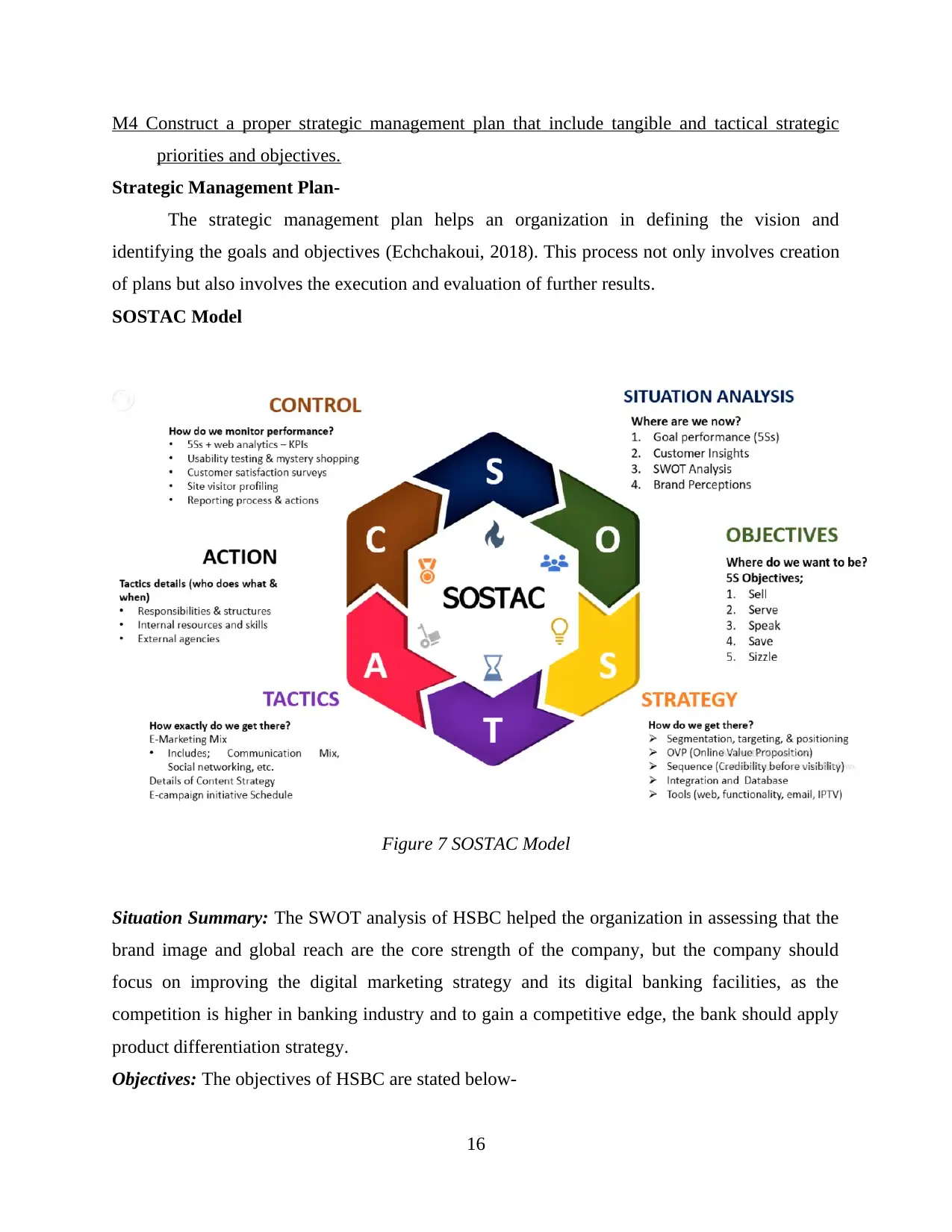
M4 Construct a proper strategic management plan that include tangible and tactical strategic
priorities and objectives.
Strategic Management Plan-
The strategic management plan helps an organization in defining the vision and
identifying the goals and objectives (Echchakoui, 2018). This process not only involves creation
of plans but also involves the execution and evaluation of further results.
SOSTAC Model
Figure 7 SOSTAC Model
Situation Summary: The SWOT analysis of HSBC helped the organization in assessing that the
brand image and global reach are the core strength of the company, but the company should
focus on improving the digital marketing strategy and its digital banking facilities, as the
competition is higher in banking industry and to gain a competitive edge, the bank should apply
product differentiation strategy.
Objectives: The objectives of HSBC are stated below-
16
priorities and objectives.
Strategic Management Plan-
The strategic management plan helps an organization in defining the vision and
identifying the goals and objectives (Echchakoui, 2018). This process not only involves creation
of plans but also involves the execution and evaluation of further results.
SOSTAC Model
Figure 7 SOSTAC Model
Situation Summary: The SWOT analysis of HSBC helped the organization in assessing that the
brand image and global reach are the core strength of the company, but the company should
focus on improving the digital marketing strategy and its digital banking facilities, as the
competition is higher in banking industry and to gain a competitive edge, the bank should apply
product differentiation strategy.
Objectives: The objectives of HSBC are stated below-
16
Secure Best Marks with AI Grader
Need help grading? Try our AI Grader for instant feedback on your assignments.
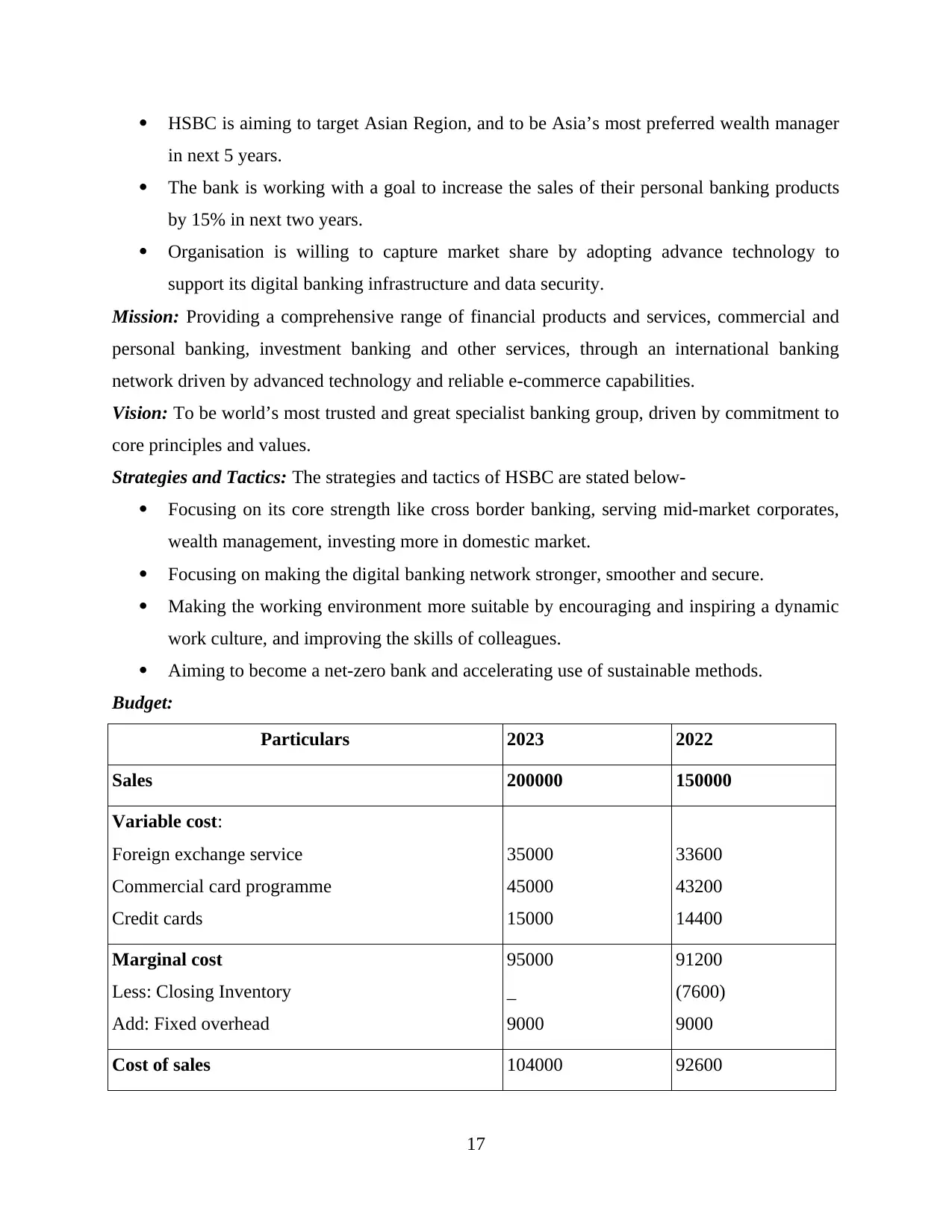
HSBC is aiming to target Asian Region, and to be Asia’s most preferred wealth manager
in next 5 years.
The bank is working with a goal to increase the sales of their personal banking products
by 15% in next two years.
Organisation is willing to capture market share by adopting advance technology to
support its digital banking infrastructure and data security.
Mission: Providing a comprehensive range of financial products and services, commercial and
personal banking, investment banking and other services, through an international banking
network driven by advanced technology and reliable e-commerce capabilities.
Vision: To be world’s most trusted and great specialist banking group, driven by commitment to
core principles and values.
Strategies and Tactics: The strategies and tactics of HSBC are stated below-
Focusing on its core strength like cross border banking, serving mid-market corporates,
wealth management, investing more in domestic market.
Focusing on making the digital banking network stronger, smoother and secure.
Making the working environment more suitable by encouraging and inspiring a dynamic
work culture, and improving the skills of colleagues.
Aiming to become a net-zero bank and accelerating use of sustainable methods.
Budget:
Particulars 2023 2022
Sales 200000 150000
Variable cost:
Foreign exchange service
Commercial card programme
Credit cards
35000
45000
15000
33600
43200
14400
Marginal cost
Less: Closing Inventory
Add: Fixed overhead
95000
_
9000
91200
(7600)
9000
Cost of sales 104000 92600
17
in next 5 years.
The bank is working with a goal to increase the sales of their personal banking products
by 15% in next two years.
Organisation is willing to capture market share by adopting advance technology to
support its digital banking infrastructure and data security.
Mission: Providing a comprehensive range of financial products and services, commercial and
personal banking, investment banking and other services, through an international banking
network driven by advanced technology and reliable e-commerce capabilities.
Vision: To be world’s most trusted and great specialist banking group, driven by commitment to
core principles and values.
Strategies and Tactics: The strategies and tactics of HSBC are stated below-
Focusing on its core strength like cross border banking, serving mid-market corporates,
wealth management, investing more in domestic market.
Focusing on making the digital banking network stronger, smoother and secure.
Making the working environment more suitable by encouraging and inspiring a dynamic
work culture, and improving the skills of colleagues.
Aiming to become a net-zero bank and accelerating use of sustainable methods.
Budget:
Particulars 2023 2022
Sales 200000 150000
Variable cost:
Foreign exchange service
Commercial card programme
Credit cards
35000
45000
15000
33600
43200
14400
Marginal cost
Less: Closing Inventory
Add: Fixed overhead
95000
_
9000
91200
(7600)
9000
Cost of sales 104000 92600
17
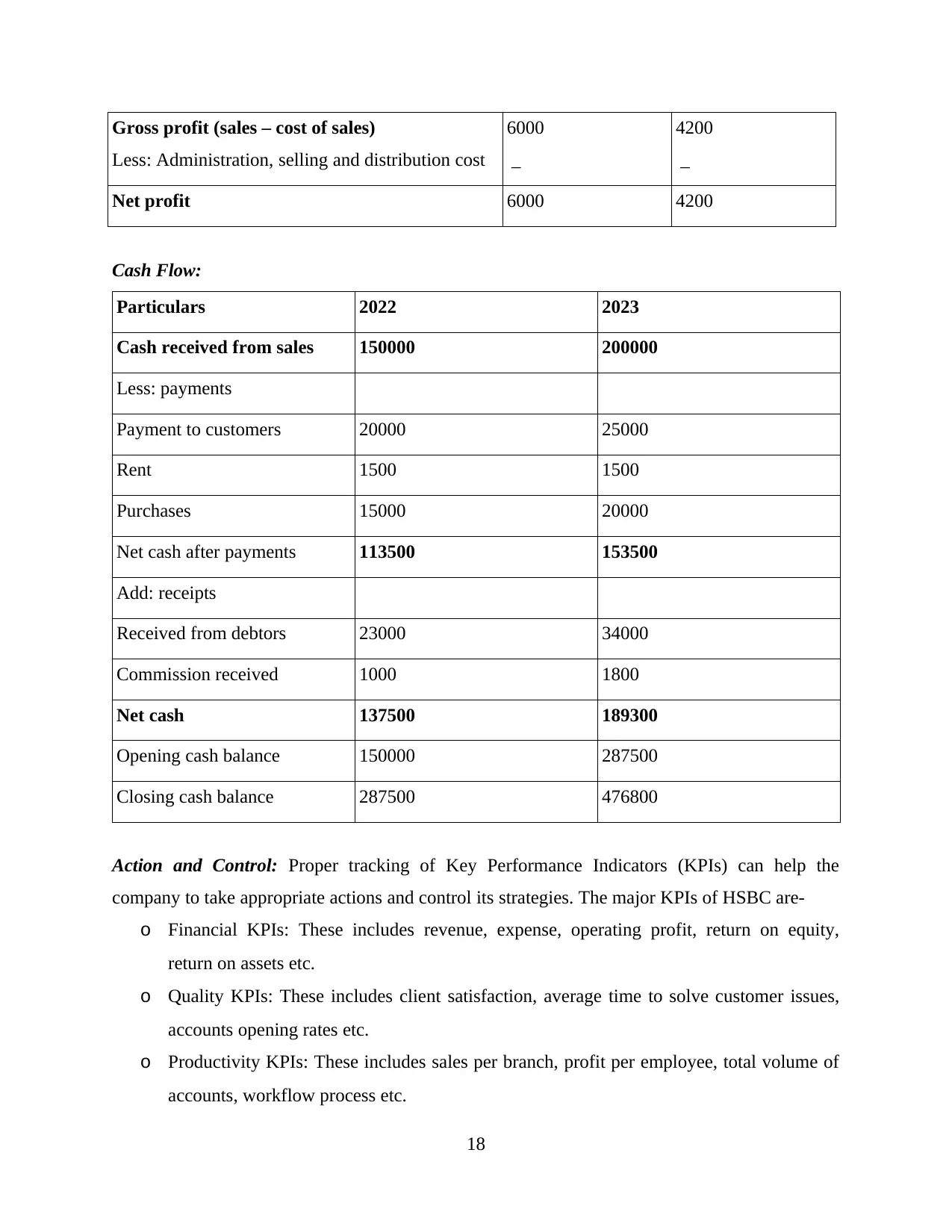
Gross profit (sales – cost of sales)
Less: Administration, selling and distribution cost
6000
_
4200
_
Net profit 6000 4200
Cash Flow:
Particulars 2022 2023
Cash received from sales 150000 200000
Less: payments
Payment to customers 20000 25000
Rent 1500 1500
Purchases 15000 20000
Net cash after payments 113500 153500
Add: receipts
Received from debtors 23000 34000
Commission received 1000 1800
Net cash 137500 189300
Opening cash balance 150000 287500
Closing cash balance 287500 476800
Action and Control: Proper tracking of Key Performance Indicators (KPIs) can help the
company to take appropriate actions and control its strategies. The major KPIs of HSBC are-
o Financial KPIs: These includes revenue, expense, operating profit, return on equity,
return on assets etc.
o Quality KPIs: These includes client satisfaction, average time to solve customer issues,
accounts opening rates etc.
o Productivity KPIs: These includes sales per branch, profit per employee, total volume of
accounts, workflow process etc.
18
Less: Administration, selling and distribution cost
6000
_
4200
_
Net profit 6000 4200
Cash Flow:
Particulars 2022 2023
Cash received from sales 150000 200000
Less: payments
Payment to customers 20000 25000
Rent 1500 1500
Purchases 15000 20000
Net cash after payments 113500 153500
Add: receipts
Received from debtors 23000 34000
Commission received 1000 1800
Net cash 137500 189300
Opening cash balance 150000 287500
Closing cash balance 287500 476800
Action and Control: Proper tracking of Key Performance Indicators (KPIs) can help the
company to take appropriate actions and control its strategies. The major KPIs of HSBC are-
o Financial KPIs: These includes revenue, expense, operating profit, return on equity,
return on assets etc.
o Quality KPIs: These includes client satisfaction, average time to solve customer issues,
accounts opening rates etc.
o Productivity KPIs: These includes sales per branch, profit per employee, total volume of
accounts, workflow process etc.
18
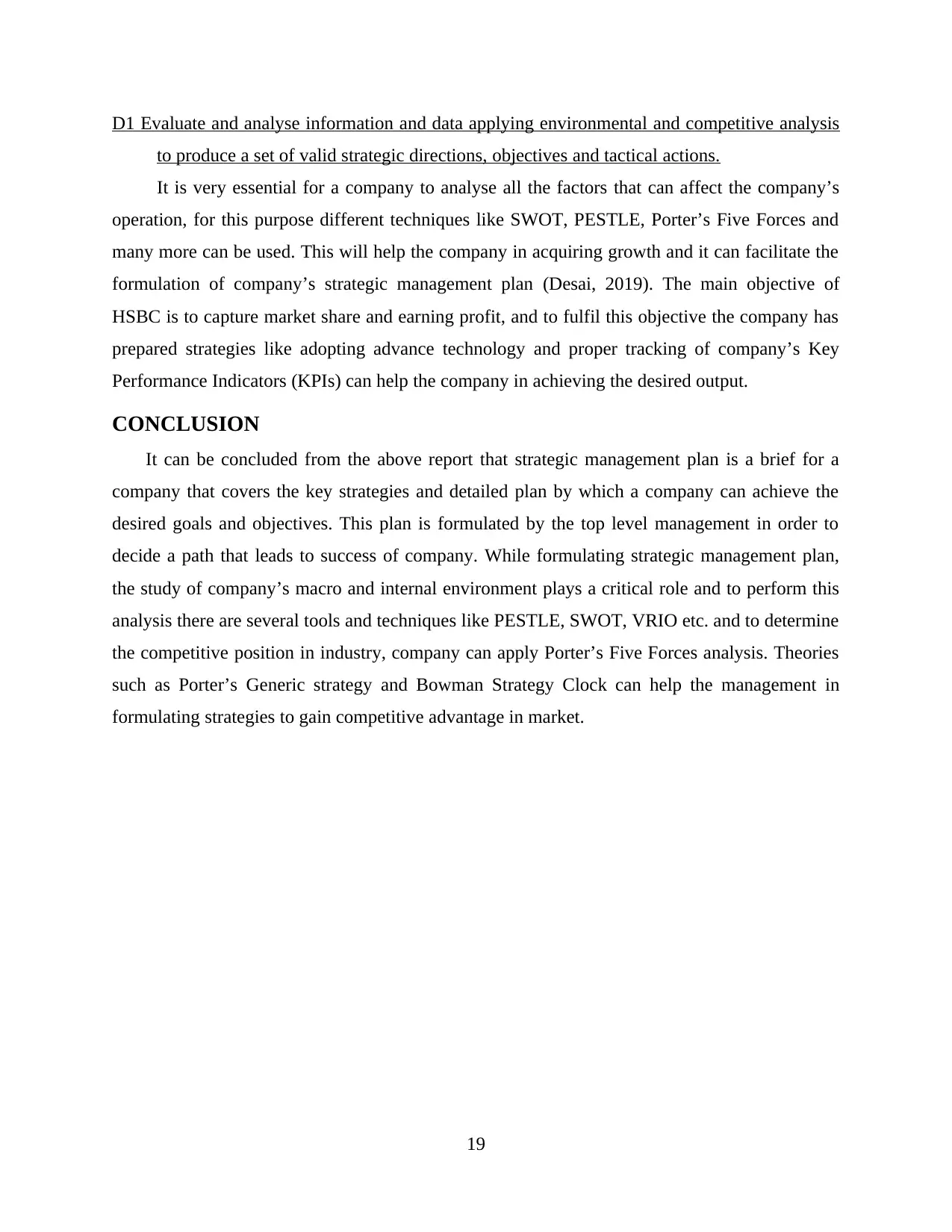
D1 Evaluate and analyse information and data applying environmental and competitive analysis
to produce a set of valid strategic directions, objectives and tactical actions.
It is very essential for a company to analyse all the factors that can affect the company’s
operation, for this purpose different techniques like SWOT, PESTLE, Porter’s Five Forces and
many more can be used. This will help the company in acquiring growth and it can facilitate the
formulation of company’s strategic management plan (Desai, 2019). The main objective of
HSBC is to capture market share and earning profit, and to fulfil this objective the company has
prepared strategies like adopting advance technology and proper tracking of company’s Key
Performance Indicators (KPIs) can help the company in achieving the desired output.
CONCLUSION
It can be concluded from the above report that strategic management plan is a brief for a
company that covers the key strategies and detailed plan by which a company can achieve the
desired goals and objectives. This plan is formulated by the top level management in order to
decide a path that leads to success of company. While formulating strategic management plan,
the study of company’s macro and internal environment plays a critical role and to perform this
analysis there are several tools and techniques like PESTLE, SWOT, VRIO etc. and to determine
the competitive position in industry, company can apply Porter’s Five Forces analysis. Theories
such as Porter’s Generic strategy and Bowman Strategy Clock can help the management in
formulating strategies to gain competitive advantage in market.
19
to produce a set of valid strategic directions, objectives and tactical actions.
It is very essential for a company to analyse all the factors that can affect the company’s
operation, for this purpose different techniques like SWOT, PESTLE, Porter’s Five Forces and
many more can be used. This will help the company in acquiring growth and it can facilitate the
formulation of company’s strategic management plan (Desai, 2019). The main objective of
HSBC is to capture market share and earning profit, and to fulfil this objective the company has
prepared strategies like adopting advance technology and proper tracking of company’s Key
Performance Indicators (KPIs) can help the company in achieving the desired output.
CONCLUSION
It can be concluded from the above report that strategic management plan is a brief for a
company that covers the key strategies and detailed plan by which a company can achieve the
desired goals and objectives. This plan is formulated by the top level management in order to
decide a path that leads to success of company. While formulating strategic management plan,
the study of company’s macro and internal environment plays a critical role and to perform this
analysis there are several tools and techniques like PESTLE, SWOT, VRIO etc. and to determine
the competitive position in industry, company can apply Porter’s Five Forces analysis. Theories
such as Porter’s Generic strategy and Bowman Strategy Clock can help the management in
formulating strategies to gain competitive advantage in market.
19
Paraphrase This Document
Need a fresh take? Get an instant paraphrase of this document with our AI Paraphraser
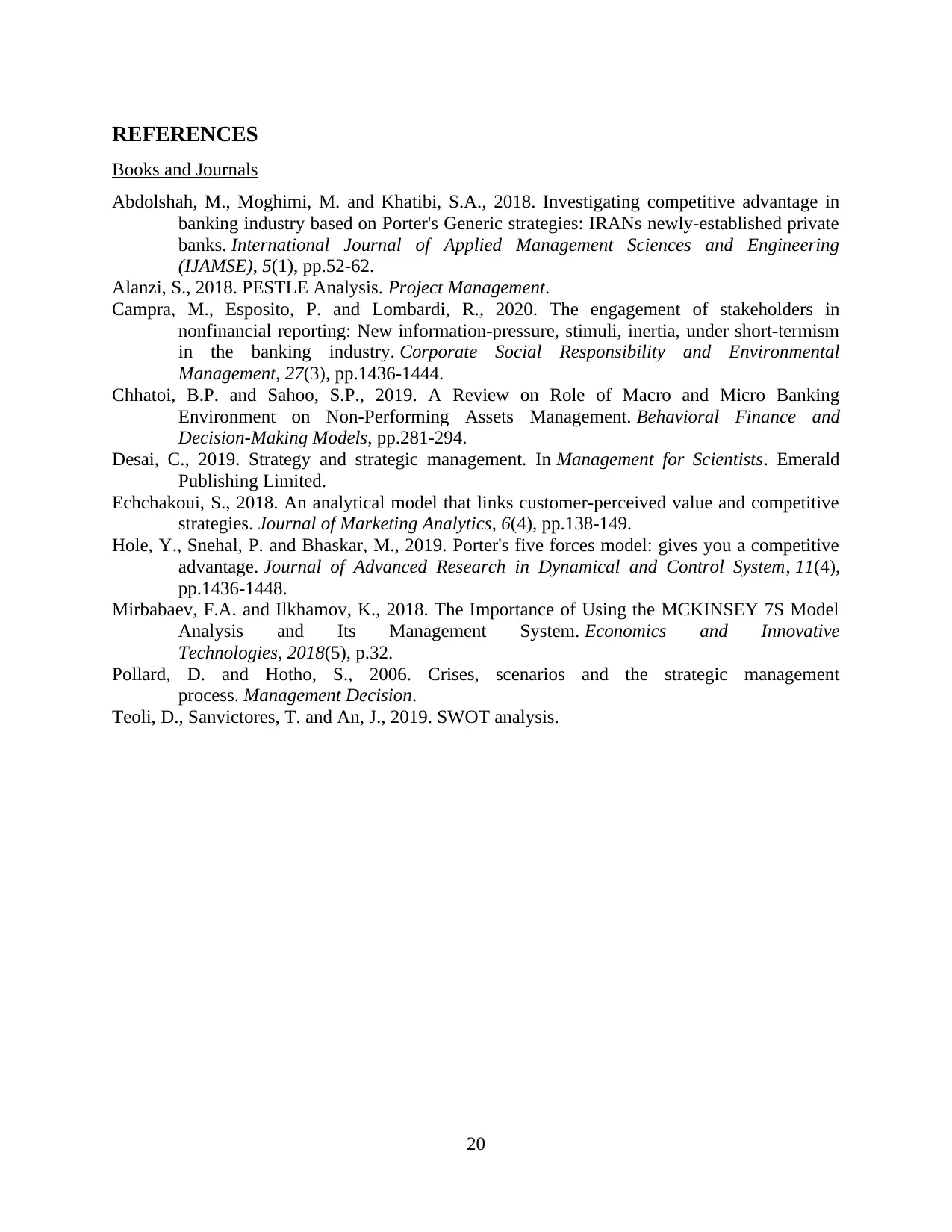
REFERENCES
Books and Journals
Abdolshah, M., Moghimi, M. and Khatibi, S.A., 2018. Investigating competitive advantage in
banking industry based on Porter's Generic strategies: IRANs newly-established private
banks. International Journal of Applied Management Sciences and Engineering
(IJAMSE), 5(1), pp.52-62.
Alanzi, S., 2018. PESTLE Analysis. Project Management.
Campra, M., Esposito, P. and Lombardi, R., 2020. The engagement of stakeholders in
nonfinancial reporting: New information‐pressure, stimuli, inertia, under short‐termism
in the banking industry. Corporate Social Responsibility and Environmental
Management, 27(3), pp.1436-1444.
Chhatoi, B.P. and Sahoo, S.P., 2019. A Review on Role of Macro and Micro Banking
Environment on Non-Performing Assets Management. Behavioral Finance and
Decision-Making Models, pp.281-294.
Desai, C., 2019. Strategy and strategic management. In Management for Scientists. Emerald
Publishing Limited.
Echchakoui, S., 2018. An analytical model that links customer-perceived value and competitive
strategies. Journal of Marketing Analytics, 6(4), pp.138-149.
Hole, Y., Snehal, P. and Bhaskar, M., 2019. Porter's five forces model: gives you a competitive
advantage. Journal of Advanced Research in Dynamical and Control System, 11(4),
pp.1436-1448.
Mirbabaev, F.A. and Ilkhamov, K., 2018. The Importance of Using the MCKINSEY 7S Model
Analysis and Its Management System. Economics and Innovative
Technologies, 2018(5), p.32.
Pollard, D. and Hotho, S., 2006. Crises, scenarios and the strategic management
process. Management Decision.
Teoli, D., Sanvictores, T. and An, J., 2019. SWOT analysis.
20
Books and Journals
Abdolshah, M., Moghimi, M. and Khatibi, S.A., 2018. Investigating competitive advantage in
banking industry based on Porter's Generic strategies: IRANs newly-established private
banks. International Journal of Applied Management Sciences and Engineering
(IJAMSE), 5(1), pp.52-62.
Alanzi, S., 2018. PESTLE Analysis. Project Management.
Campra, M., Esposito, P. and Lombardi, R., 2020. The engagement of stakeholders in
nonfinancial reporting: New information‐pressure, stimuli, inertia, under short‐termism
in the banking industry. Corporate Social Responsibility and Environmental
Management, 27(3), pp.1436-1444.
Chhatoi, B.P. and Sahoo, S.P., 2019. A Review on Role of Macro and Micro Banking
Environment on Non-Performing Assets Management. Behavioral Finance and
Decision-Making Models, pp.281-294.
Desai, C., 2019. Strategy and strategic management. In Management for Scientists. Emerald
Publishing Limited.
Echchakoui, S., 2018. An analytical model that links customer-perceived value and competitive
strategies. Journal of Marketing Analytics, 6(4), pp.138-149.
Hole, Y., Snehal, P. and Bhaskar, M., 2019. Porter's five forces model: gives you a competitive
advantage. Journal of Advanced Research in Dynamical and Control System, 11(4),
pp.1436-1448.
Mirbabaev, F.A. and Ilkhamov, K., 2018. The Importance of Using the MCKINSEY 7S Model
Analysis and Its Management System. Economics and Innovative
Technologies, 2018(5), p.32.
Pollard, D. and Hotho, S., 2006. Crises, scenarios and the strategic management
process. Management Decision.
Teoli, D., Sanvictores, T. and An, J., 2019. SWOT analysis.
20
1 out of 20
Related Documents
Your All-in-One AI-Powered Toolkit for Academic Success.
+13062052269
info@desklib.com
Available 24*7 on WhatsApp / Email
![[object Object]](/_next/static/media/star-bottom.7253800d.svg)
Unlock your academic potential
© 2024 | Zucol Services PVT LTD | All rights reserved.



